
























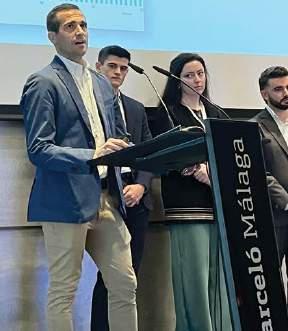
NEWS 164
Luxembourg tramway completes Airport extension; Prague opens new depot.
EU LIgh T RAIL CON g RESS 168
TAUT reports on this year’s European Light Rail Congress, held in Malaga.
JE RUSALEM EM b RACES LRT 173
Israel’s capital city has just celebrated the opening of its north-south Red Line corridor – and is seeking to open more.
d OU b LIN g U p IN LE h AVRE 179 Andrew Thompson explores this French city, set to double its LRT network size.
INTE g RATE d TRAMWAYS 181
Richard Foster talks to Create Streets about how tramways can be better integrated into urban planning to help solve the UK’s housing crisis.
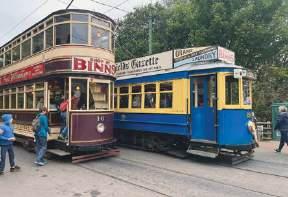
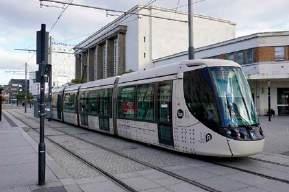
SYSTEMS fACT f ILE : p RAg UE 184
TAUT reports on Europe’s fastest-growing LRT system as it celebrates 150 years.
UIT p: T h E 2025 SUMMIT 191 TAUT speaks to UITP’s Secretary General Mohamed Mezghani about what to expect from this year’s event.
WORL d WI d E REVIEW 193
Toronto starts depot expansion; Kraków welcomes new Duewag trams.
T h E VALUE O f MUSEUMS 197
UKTram considers the intersection of history and tourism, and how tram preservation can help to drive the future.
CLASSIC TRAMS:
pENNSYLVANIA MUSEUM pART 2 198
Mike Russell continues his discovery of the Pennsylvania Trolley Museum.
How should we look after ourselves?

Thanks to the US President Donald Trump, the word of the moment is ‘tariff’, as the vociferous leader of the world’s most powerful country sets out his stall to make his nation great again. To re-establish its manufacturing base, this means imposing disruptive and seemingly limitless financial penalties on countries he believes have taken advantage of its weaknesses.
This could spark all-out retaliation, and we wait to see whether other countries copy Trump’s tactics by imposing their own taxes on countries they don’t like. China in particular could be in the firing line.
International concerns such as Alstom have 12 major plants in the US, involved in new build, refurbishment and component supply across the spectrum from light rail to suburban, regional and high speed, and seem unlikely to take a big hit as 95% of the contents of its products are domestically sourced.
There is no doubt that the world faces difficult times. Given that buyers from Canada to Europe are already changing their buying habits in response to US politics, how about buying trams from China, breaking the ‘buy locally’ convention? We are talking about Metro de Porto in Portugal, where a second tram order has been placed with a Chinese organisation, this time for the northern city’s new Casa da Música-Santo Ovidio route. In this issue, we report how CRRC Tanjsham is building 22 new foursection units for delivery within two years, doubtless having secured the deal because they are very, very cheap. Porto also chose China for 18 trams back in 2023, the first European city to break rank.

MAY 2025 Vol. 88 No. 1049 www.tautonline.com
EDITORIAL
Edi T or – Matt Johnston matt@mainspring.co.uk
Associ ATE Edi T or – Tony Streeter tony.streeter@mainspring.co.uk
WorldW id E Edi T or – Michael Taplin miketap@mainspring.co.uk
sE nior c on T ribu T or s –howard Johnston , Neil p ulling
WO rldW id E C ONT ribu TO r S r ichard Foster, Andrew Grahl, Andrew Moglestue, Herbert Pence, Mike russell, nikolai s emyonov, Alain s enut, Andrew Thompson, Witold urbanowicz, bill Vigrass, Thomas Wagner, Philip Webb.
Produc T ion – Lanna blyth Tel: +44 (0)1733 367604 production@mainspring.co.uk
d E si G n – d ebbie Nolan A Dv ERTI s I ng
co MME rci A l M A n AGE r – g eoff b utler Tel: +44 (0)1733 367610 geoff@mainspring.co.uk
Tramways & Urban Transit 13 o rton Enterprise centre, b akewell road, Peterborough PE2 6X u u K
Tramways & Urban Transit is published by Mainspring on behalf of the lrTA on the third Friday of each month preceding the cover date.
LRTA MEM b ERS h I p (with TAUT subscription) Tramways & Urban Transit is sent free to all paid-up members of the l ight r ail Transit Association.
lrTA WE bsi TE A nd di A rY Tim Kendell webmaster@lrta.org meetings@lrta.org
sU bsc RI p TIO ns, MEM b ER s HI p A n D b Ack I ss UE s lrTA Membership s ecretary ( d ept T06), 38 Wolseley road, s ale M33 7Au, u K. Tel: +44 (0)117 951 7785 membership@lrta.org Website: www.lrta.org f OR c OR p ORATE sU bsc RI p TIO ns v I s IT www.mainspring.co.uk
LRTA RE g ISTERE d Off ICE 13 o rton Enterprise centre, b akewell road, Peterborough PE2 6X u, u K Private company limited by guarantee, no. 5072319 in England and Wales.
lrTA cHA ir MA n – paul Rowen chair@lrta.org
© lrTA 2025
Articles are submitted on the understanding they may also be used on our websites or in other media. A contribution is accepted on the basis that its author is responsible for the opinions expressed in it, and such opinions are not those of the LRTA or Mainspring. All rights reserved. No part of this magazine may be reproduced or transmitted in any form by any means, electronic or mechanical, including photocopying, recording or by any information storage and retrieval system, without prior permission in writing from the copyright owner. Multiple copying of the contents of the magazine without prior written approval is not permitted.
The
Matt Johnston, Editor
Other systems across Europe face a dilemma over whether they should protect domestic manufacturers and the hundreds of companies that supply them... or simply cave in to attractive product prices.
COVER: An Alstom Citadis 302 crosses in front of the old town walls in Jerusalem, the historic city in Israel, which has fully embraced LRT. JTMT
Construction starts on Sheffield stop
Work has started on a GBP9m (EUR10.7m) addition to the Sheffield Supertram network (UK): a new tram-train stop close to the Magna Science Adventure Centre. Network Rail will oversee construction on behalf of South Yorkshire Mayoral Combined Authority. The contractor is AmcoGiffin.
The stop will comprise two platforms either side of the doubletrack line between Meadowhall and Rotherham. It is to make use of car parking at Magna SAC.
Magna is due to open in late 2025. Weekend track possessions mean that replacement buses will continue to connect Meadowhall, Rotherham Central and Parkgate tram stops on Saturday evenings.
Clyde plans move forward Strathclyde Partnership for Transport (UK) has said that “progress on the delivery of the Clyde Metro Programme [Case for Investment] remains positive and is moving at pace”.
A progress report, published on 24 February ahead of a meeting on 14 March, said that CFI Stages 1a and 1b were to be completed by March and that work on Stage 2 – the Programme Business Case – would then begin.
Some Stage 2 contract approvals have already been awarded. The CFI work is due to be completed in 2027; from there, detailed appraisals including engineering design and costings, plus a Programme Level Business Case, can be made.
The Clyde Metro is likely to involve a mix of light and heavy rail, but could also involve bus rapid transit too.
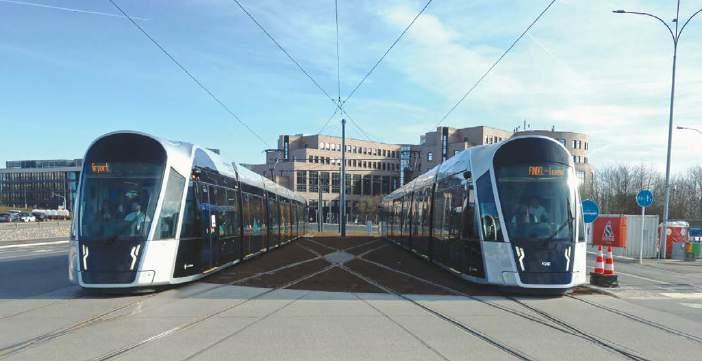
Luxembourg’s 16.2km (ten-mile) initial tramline was completed on 2 March when the final piece – the 3.9km (2.4mile) extension to Luxembourg Airport – opened for passengers.
The new extension includes tracks in the central reservation of the A1 motorway through the Grünwald forest, where 70km/h (43mph) can be reached. There is
one intermediate stop, Héienhaff P+R. Trams run every eight minutes during the day, with the first departure from the airport at 05.03 and the last at 00.06. Surveys indicate that up to 50% of airport users could choose to travel by tram. Yuriko Backes, Minister of Mobility & Public Works, said: “The tramway is reaching a key stage in its expansion, thus
Praha’s (Prague’s) first new tram depot for 74 years opened on 22 March. It has been built on the site of the former Hloub ětín depot that was demolished in 2019 after structural problems made it unsafe.
The new depot serving the Czech capital will despatch trams on operator DPP’s lines 7, 8, 12, 17 and 31. It will serve as the main base for the system’s Škoda 52T trams. The 17-track depot building has stabling for up to 61 32m trams. It also has a six-track workshop as well as a service building for DPP’s overhead line department, and modern vehicle washing facilities.
Photovoltaic panels generate enough electricity to run the site and are supplemented by heat pumps, while the ventilation
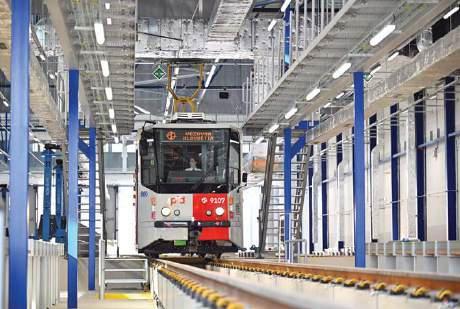
ABOVE: A DPP Tatra KT8 inside the new depot. DPP
systems use heat recovery systems. Rainwater is recycled. Fully funded through the city’s municipal budget, the CZK1.9bn
(EUR76.4m) project beings to an end the temporary arrangement of stationing trams outside at the Hostiva ř workshop.
strengthening the attractiveness of public transport. The commissioning of the tram at the airport represents a major step forward, facilitating access and offering an efficient and sustainable mobility alternative.” Luxembourg’s first section of new tramway opened in December 2017. Work will start this year on further lines to be opened in 2027 and 2035.
Alstom has sold its Görlitz rolling stock factory to defence contractor KNDS Deutschland GmbH. The sale was concluded on 5 February.
Existing contracts will be handled until 2027. KNDS hopes that nearly 600 of the 700-strong workforce will be retained when the German site starts building tanks and other armoured vehicles.
Florian Hohenwarter of KNDS said: “With the new Görlitz location in the KNDS production network, we are expanding our capacities with a highly specialised production facility. In Görlitz, we have access to exceptionally welltrained specialists who enable us to manufacture high-quality assemblies for our vehicles.”
New office created to streamline permit process
Seattle Mayor and Sound Transit board member Bruce Harrell has issued an executive order to accelerate the delivery of new light rail lines. The new Office of the Waterfront, Civic Projects and Sound Transit (OWCPST), is to lead the development of new legislation to streamline the permit process for the projects.
The OWCPST will also create a four-year work plan to improve rider experience. Budgets of USD5.2m (EUR4.8m) for 2025 and USD6.8m (EUR6.3m) for 2026 will fund up to 50 additional staff to support the effort.
The new office should benefit two new projects. The Ballard Link extension will add 12.3km (7.7 miles) of light rail connecting the city centre to
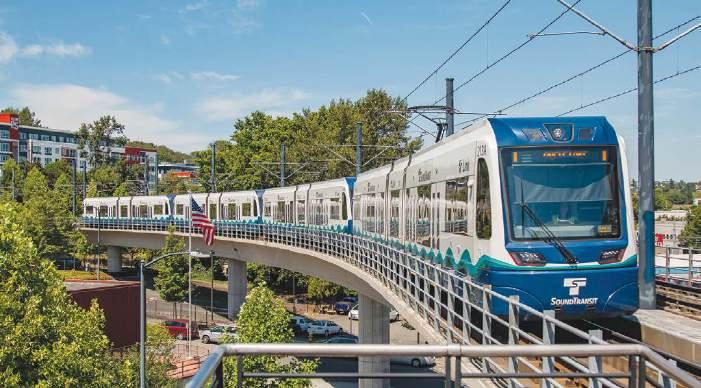
Ballard. It is set to boast nine new stations and a second downtown transit subway, and is scheduled to be completed in 2039. The West Seattle Link extension is a 6.6km (4.1-mile) line from the
city centre to West Seattle with four new stations and a bridge over the Duwamish River. It is to be completed in 2032.
Light rail came to Seattle in August 2003, with the north-
PESA’s Twist 3.0 has been selected by the Polish city of Kraków. Operator MPK is initially expected to receive 15 of the following versions: 32m singleended at PLN17.3m (EUR4.1m) each; 32m double-ended at PLN18.6m (EUR4.4m) each; 45m single-ended at PLN28.5m (EUR6.8m) each.
Delivery is due to start in 2028. However, the framework contract has options that could amount to 90 new trams, although it is
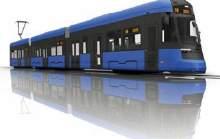
not clear how that would be split across the three variants.
The only competition for
PESA came for the 45m trams, for which Škoda also submitted a bid. Neither Stadler nor Poland’s other tram builder, Modertrans, bid for the work.
Kraków has operated 1435mmgauge trams since 1913 and now has a 90km (56-mile), 22-line system with 292 motor trams and 59 trailers running from three depots. The new Twist cars will permit the last highfloor Konstal trams dating from 1979-92 to be withdrawn.
Rail forms a key part of London
Mayor Sir Sadiq Khan’s London Growth Plan proposals to develop the UK’s capital. Published in late February, the report shows how changes to London’s railway map could unlock new homes. Development of Crossrail 2, which could help create 200 000 new homes between Hackney and Wimbledon, is recommended under the report’s ‘ten-year plan’. This section also includes stabilising funding for Transport for London, upgrading the Bakerloo Line and
extending the Docklands Light Railway across the Thames to the Thamesmead development.
The report says that since the Elizabeth Line opened in 2022, it has supported 55 000 new homes and 60% employment growth.
The report recommends bringing “London’s suburban rail services up to the standard of the London Overground, using TfL’s expertise to run more frequent services”.
This could mean that the proposed ‘West London Orbital’, the ‘Y’-shaped system from
Hounslow to Hendon/West Hampstead (TAUT 1040), would become part of the Overground network. So could some routes currently operated by Great Northern and Southeastern. Khan has been a long-time campaigner for ‘rail devolution’. A proposed London Overground map covers Welwyn Garden City and Letchworth in the north, Windsor and Weybridge to the west, Dorking and Epsom in the south, and Upminster and Gravesend in the east.
south line using a trolleybus subway. The system has been extended and supplemented by the East Seattle line, bringing the total length to 71.9km (44.6 miles).
Skyline audit suggests improvements
Honolulu’s Skyline is due to open its next phase on 1 October. The first 17.4km (10.8 miles) of the 31km (19-mile) line opened on 30 June 2023. The next, from Hālawa to Kahauiki, is 8.5km (5.3 miles) long. However, a city audit has reported poor patronage, ineffective marketing and inadequate features for the disabled. The system was budgeted to have 8000 passengers per day but is attracting only 3637. The audit has made ten recommendations to improve performance.
Liège services delayed
The start of services on the new tramway in the Belgian city of Liège has been postponed from 15 April to 28 April. A dummy service that has been running since 11 February has revealed technical difficulties for the operator, the Tram’Ardent consortium, to resolve.
Linking Sclessin and Coronmeuse, and with a branch to Liège Expo, the standardgauge tramway runs for 11.7km (7.3 miles). It will operate from 05.00 to 01.00 with a 4min 30sec headway at peaks using CAF Urbos trams. These 45.4m sevensection vehicles are to run from a depot just beyond the Expo terminus.
Mayor describes deliveries as ‘only the beginning’
Croatian city Osijek took delivery of the first of ten low-floor trams from KONČAR on 7 March. Each of the air-
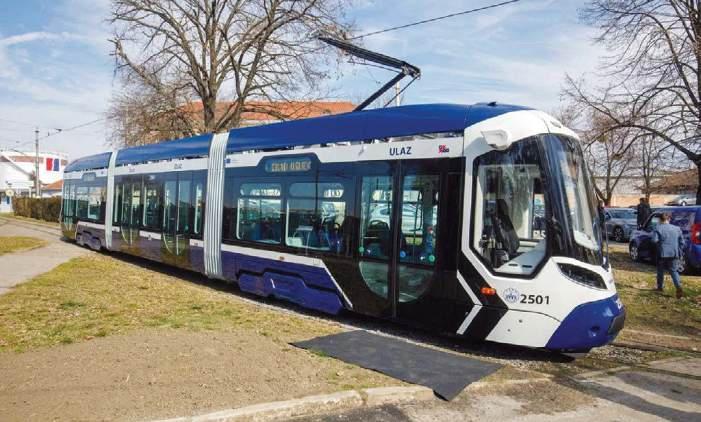
conditioned 20.8m TMK 2500 vehicles cost EUR2.3m and can accommodate 135 passengers (44 seated). Delivery should be completed by September.
Mayor Ivan Radić said: “This is only the beginning. In addition to these ten low-floor trams, we have a framework agreement for ten more. With the support of the Croatian Government and
Colas Rail UK has started to install Very Light Rail on Queen Victoria Road in Coventry. Work started on the 220m test section in the West Midlands city in late February; it should be operational in time for a planned four-week ‘showcase’ during the summer.
Councillor Jim O’Boyle took to social media to invite residents to inspect the new system, which aims to reduce UK tramway construction costs from GBP100m (EUR119.5m) per km to GBP25m (EUR30m) per km by creating a shallower formation
than those for conventional schemes.
“You’ll get an opportunity once it’s opened up and running in the spring to come and have a ride in it”, O’Boyle said.
“When people said CVLR wasn’t going to happen, the evidence is for yourself to see. It is happening. Work is beginning, the track system’s going in, the rails will be going in and you’ll have the opportunity, as a city resident to have a go and we’ll have businesses, people from all over the country coming to have a look”.
the Ministry of Transport, we are building a 20-tram fleet that will fully meet the city’s public transport needs.”
KONČAR board member Ivan Paić added: “Osijek’s investment in modernisation sets a strong example for Croatia’s green transition. [It] will soon see these trams become an integral part of daily commutes and cherished
city experiences.”
Osijek’s metre-gauge tramway dates back to 1884. The 12km (7.5-mile) system was suspended in 2023-24 whilst infrastructure was modernised at a cost of EUR45m. The TMK 2500 trams replace its 17 Pragoimex trams, dating from 2006-07 but which are themselves modernised Tatra vehicles built between 1968-82.
A business case has been submitted to the UK government for the replacement of the Tyne & Wear Metro’s signalling system. The project is expected to cost some GBP400m (EUR478m).
Replacing the Metro’s signalling, which dates back to the 1970s/80s, is the final piece in the GBP1bn (EUR1.2bn) jigsaw to rejuvenate the system. This work started in 2010 and has included major track renewals, overhead line upgrades and delivery of the new Class 555 fleet from Stadler.
Cathy Massarella, Managing Director of Metro operator
US international railway investment company Railroad Development Corporation and TDI Greenway, the British developer of Very Light Rail stock, are to merge their Pop-Up metro and VLR sectors.
RDC is taking a 50% stake in TDI Greenway.
Pop-Up Metro has been developing projects for low-cost passenger services in North America, using existing freight lines and re-worked former London Underground D Stock
RDC Chairman Henry Posner III said: “RDC’s business model is based on partnerships.
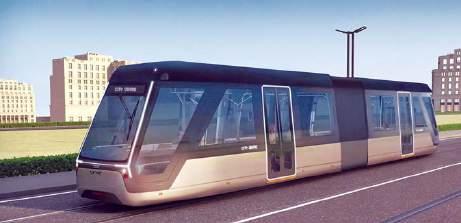
By combining our Pop-Up Metro subsidiary with TDI Greenway, we will gain the breadth and capability to more rapidly
advance projects in North America and abroad. We have admired TDI’s tenacity, innovation and progress,
Nexus, said: “We have submitted our Strategic Outline Business Case to demonstrate the need for replacement and that has now been reviewed by the Department for Transport. We will now progress to the next stage of development and will remain in dialogue with the Government about this very important issue.”
The signalling system is blamed for 62% of all infrastructure-related delays on the Metro. The final cost of replacement will not be known until the final business case is compiled.
including its development of the VLR vehicle, and believe we are stronger together.”
TDI Greenway has developed the Revolution VLR railcar for lightly-used branch lines; UK rolling stock leasing company Eversholt has ordered three of the vehicles. It has also developed the Lync VLR tram.
RDC still wants to develop the Pop-Up metro concept using the D Stock fleet, originally acquired by Vivarail. However, that defunct company’s fast charging battery technology has been acquired by train operator Great Western Railway.
Locally-built vehicles now in use on seven lines
The 100th Alstom Flexity tram in Wien (Vienna) entered service on 1 March. They can now be seen on seven of the Austrian capital’s 28 tram lines and have already covered over 12m km (7.5m miles) in in service.
A further 30 are to arrive in 2025 for Lines D, 43 and 1.
Peter Hanks, City Councillor for Public Transport & Finance, said: “The Flexity is a genuine Viennese product that has shaped the cityscape since 2018 and is now an integral part of our city. The new vehicles not only modernise the tram fleet but also strengthen Vienna as a production location.”
Tramway operator Wiener Linien placed an order with Bombardier Transportation for 119 Flexity low-floor trams in 2015. The contract was worth EUR431m, including a 24-year FlexCare maintenance agreement. Options exercised so far will take the total to 146 vehicles. They will replace highfloor E2 trams.
The trams are delivered from the former Bombardier factory in Wien-Donaustadt. Alstom, which bought Bombardier Transportation in January 2021, has assumed responsibility for the contract. The Flexity design has also been ordered by Austria’s second city, Graz.
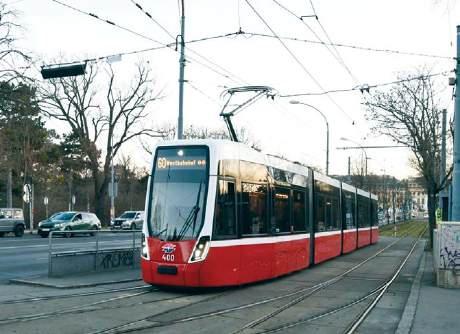
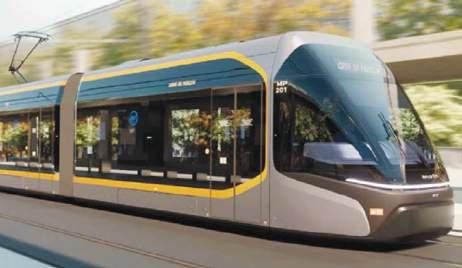
Metro do Puerto, operator of the light rail system in the Portuguese city of Porto, has placed an order with Chinese manufacturer CRRC Tangshan for 22 new four-section 35m LRVs. The cars will be delivered in 2026-27 for the 6.3km (3.9-mile) Ruby Line H. This is still under construction between Casa da Música in the city centre and the southern suburb of Santo Ovidio. There is an option for ten further vehicles.
This is the second time that Metro do Porto has chosen the Chinese manufacturer. The 18
Consultant AtkinsRéalis has proposed that tram-trains could help connect North and South Wales, UK. The report North South West Wales Feasibility was commissioned by Transport for Wales.
The overall aim would be to reopen two long-closed railways: from Bangor to Afon Wen (on the former Cambrian line to Pwllheli), which closed throughout in 1964, as well as Aberystwyth – Carmarthen, which closed in 1965.
AtkinsRéalis’ report only deals with the 44km (27-mile) Bangor –Afon Wen line. It says: “There are
a number of challenges arising from the proposed reopening of the Afon Wen to Bangor railway… nevertheless, the Feasibility Study has identified a potential indicative preferred route… for the whole length between Bangor and Afon Wen.”
Of those challenges, a major obstacle is the Welsh Highland Railway, which operates on the trackbed between Caernarfon and Dinas. The study proposes sharing the same formation with the WHR where possible and building a new stop at Dinas, away from the WHR’s main engineering base.
Civil engineering students from Heriot-Watt University are leading a campaign to convert a freight-only railway through Edinburgh (UK) to tram-train operation.
The proposal for the 12.3km (7.6-mile) line would include 11 stops between Gorgie – to the west of Haymarket – and Portobello, where the ‘South Sub’ meets the East Coast Main Line. In order to reduce the cost of the system, the students propose using battery-powered tram trains.
LRVs that entered service in 2023 became the first urban rail vehicles to be exported from China to an EU country.
The cars can accommodate 244 passengers (64 seated). They are to have aluminium bodies with seven double doors each side and will be equipped with communications-based train control for attended automatic operation.
The EUR69.5m deal has been financed by the Sustainable 2030 programme and the Environmental fund. It will bring the fleet to 144 vehicles.
CAF to buy Modertrans?
Spanish rolling stock builder CAF is leading the race to acquire Polish tram builder Modertrans. As we closed for press, reports were coming in that CAF would take on the 85% of the business currently owned by Poznań’s tram operator MPK Poznań. The city owns the other 15%. The deal reportedly hinges around whether city officials will approve a new paintshop at the factory.
Modertrans launched in 2005 and has built more than 500 trams on its Moderus Alfa, Beta and Gamma platforms. It also operates a repair and upgrade business.
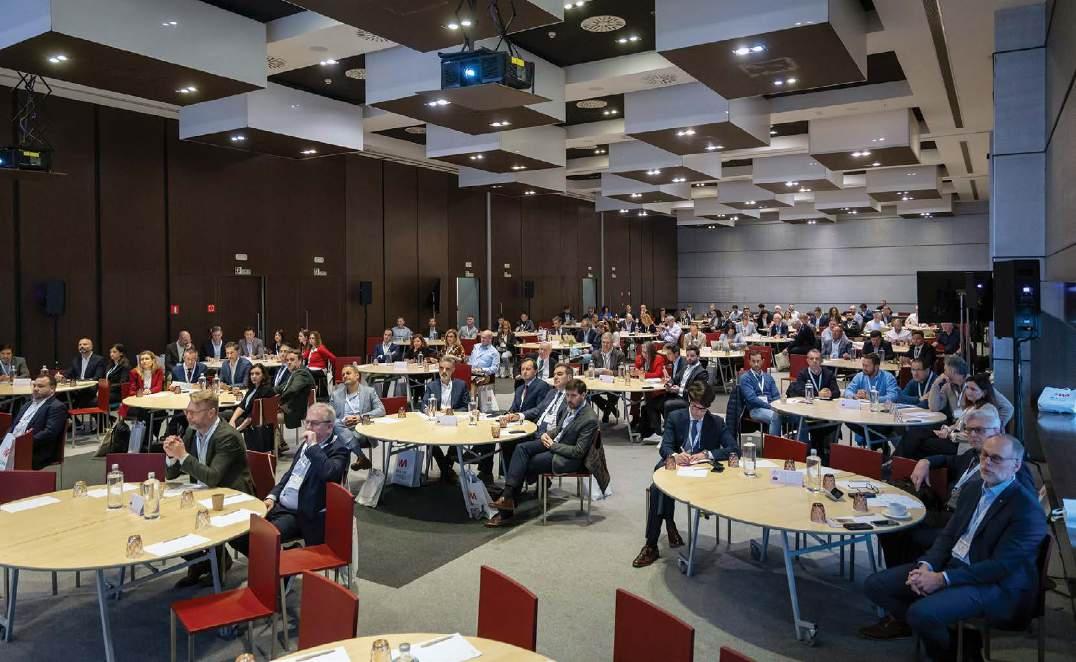
in an uncertain world, it’s important for our industry to be at the top of its game. geoff Butler’s review of this year’s two-day event in Malaga shows that challenges are being confronted head-on.
Where will Europe’s light rail industry be in five, ten and 20 years’ time? Despite all the current economic instability across the globe, there is complete agreement that quality public transport is essential to oil the wheels of every civilised nation.
This was confirmed by the 200 attendees at the 2025 European Light Rail Congress in Malaga, Spain on 19-20 March. They were altogether upbeat as they discussed how Artificial Intelligence and automation continue to make great strides, while new vehicle designs improve the passenger experience and safety, and help the move towards net zero.
The heavy rain and overcast skies that greeted the majority of attendees on the opening day didn’t dampen anyone’s spirits as senior and key professionals met to talk all things light rail, sharing best practice, ideas and thoughts, the challenges they face, and how they are being overcome.
Metro Malaga is an award-winning two-line system designed to bring city life together, which is successfully achieving its objectives. The two routes join up at El Perchel station, where you can also access the AVE high-speed service, Media Distancia, Regionales and Cercanías network, as well as the inter-city bus station.
In his welcoming remarks, President of Metro Malaga (MM) Francisco Gambero explained what has been achieved to improve transport connections between the city and the larger Andalucian region, and events such as the European Light Rail Congress were the ideal framework for discussion on the best ways forward. Jose Maria Rivera, MD
of the Agencia de Obra Publica de la Junta de Andalucia, talked about inclusivity, and the need for good, efficient and sustainable transport for all. He was a familiar face, having opened the 2024 event in Seville.
Fernando Lozano, Director General of Metro Malaga, continued the theme of sustainability, as well as customer satisfaction and excellence, highlighting the many testimonials received from clients around the world. MM has more passengers making more journeys, rising to 18.3 million last year.
Lozano also explained the need to extend line 2 with three new underground stations, and stressed the importance of listening and acting upon customer feedback. Ideas have included fare discounts, leaving bikes at stations, and better underground mobile phone coverage. MM now has phone apps and chatbots available for 24/7 communication, and a simulator has greatly improved driver safety.
Javier de la Cruz, Head of Digital Transformation at CAF Rail Services, spoke about how automatic inspection techniques and wayside train monitoring transform operations and maintenance. He mentioned how AI is a lever for operational efficiency along with predictive maintenance, automation and scalability. Productivity has increased, failures in diagnostics and repetitive failures are down, and so is energy usage. There are also fewer mishaps.
Juan Herrera, Project Engineer of Getzner Werkstoffe (Vorarlberg, Austria and also Spain), explained how his company’s slab track reduces vibrations on tram and metro networks. Polyurethane mats under the track ‘deform’ under load and then return to their original shape, so maintenance costs are
significantly reduced. Clients have freedom of design and added technical support in their own language during the whole process. Alstom puts the passenger to the fore, although congestion and saturated infrastructure (as well as people living longer) put more demand on the services offered. Users of e-scooters and bikes expect to be allowed onto trams, and smartphone apps and decent coverage are also now important to everyone. The presentation was given by Francois Giraud, Market and Produce Director, Light Rail, and Alexis Bonnet, Advanced & Creative Design Director, both of Alstom France
Oliver Reeves from UK-based SSG Insight talked about digital asset management and the benefits of adopting it to manage business assets more efficiently and effectively. His company is now under the Aptean banner, having been acquired late last year, and works closely with many of Britain’s light rail systems and others overseas.
While performance is important, so is sustainable maintenance practice to extend the lifespan of infrastructure, rolling stock and critical assets, often saving the need for frequent replacement. IoT (Internet of Things) sensors and real-time data analytics predict asset failure before it happens, minimising unplanned downtime and extending component lifespans. Vibration sensors, temperature monitoring, and track wear detection can identify potential issues with trains, tracks, and stations.
Dr Wolfgang Domann, Chief Commercial Officer of EYYES, an Austrian-based technology company with safety at the
LEFt: two days of sessions saw the presentation halls filled with almost 200 delegates. All images courtesy of Metro Malaga.
forefront of its thinking, outlined the use of AI for safety improvements and operations. His firm’s products include electronic and rear-view mirrors, front collision warnings, blind spot assistance, platform monitoring and ICCTV. These all effectively wrap a ‘skin’ around the whole vehicle, detecting people and other vehicles that could cause a potential danger both in daylight and at night. CCTV also supports the whole system.
Michael Moffatt, Engineering Manager of Ross Pneumatrol from Lancashire, UK, gave an insightful presentation on its rail brush product that has been deployed for over 30 years. It ensures that the railhead is kept clean to improve conductivity, adhesion and safety, and works on underground systems as well as metros and tramways. The device sits close to the wheels, and a set of spring steel tines are raised and lowered by a pneumatic cylinder. The company’s clients include Alstom, Siemens, RATP Dev, SNCF, Transdev and Transport for London.
Ana Moreno, CEO of Los Tranvias de Zaragoza, has responsibility for 110 000 daily passengers and the countless pedestrians who are close by. The Spanish city is generally a much safer place because its single line 12.8km (eight-mile) light rail system has cut city centre road traffic by 15%, and accidents are down by half over the last decade. The FAP overspeed protection system keeps control of trams on specific stretches, while anti-crush devices stop them running over obstacles. Other initiatives include an intense communication programme that includes posters, volunteers and school lessons to over 35 000 students. Physical
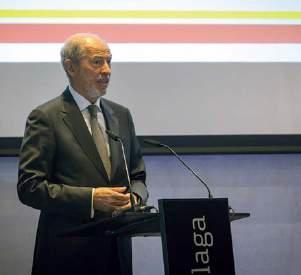
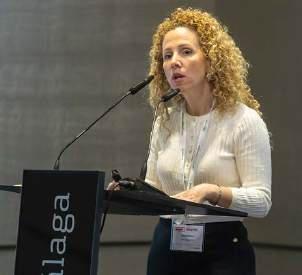
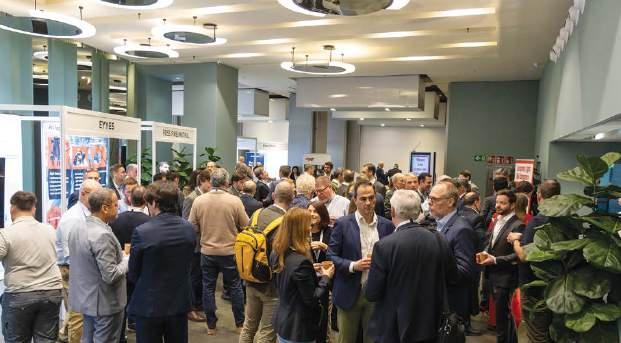
features include high-efficiency LED stripes at the busiest crossings, and beacons that detect approaching trams by turning on flashing lights.
OTIV from Gent, Belgium, is working on a new camera detection system to co-pilot tram drivers in complex environments – notably including signalling detection, audiovisual notifications, collision avoidance, active intervention, and corner speed protection.
Juan Carlos Sanchez from Voestalpine (Spain) is an advocate of rubber tyres for metro vehicles, which he says can accelerate and brake better than a conventional metro, making them ideal for metros with stops close together and on steep gradients. Michelin-type tyres were developed in Paris, and failure of the guidance wheels can be solved by extra steel wheels with deeper flanges. In cases of flat tyres, the steel wheels can also roll on the rails. Customers include
toP: there was plenty of time to network in the exhibition hall, with the opportunity to discuss and explore the topics raised in the presentations.
LEFt: Francisco gambero, President of Metro Malaga, opened this year’s event.
Right: a panel debate in the afternoon of the first day explored where light rail could be in five, ten or 20 years’ time.
LEFt: teresa Benet, Metro de tenerife’s international Business Development Manager, described the driver assistance system simove, and Viamovil, a paperless ticketing system.
Right: an evening networking dinner was hosted at La Pergola restaurant on the first night of the Congress.
systems in Montreal, Paris, Lyon, Marseille, Lausanne, Mexico City and Santiago (Chile).
After a break, Dan Hill, Technical Officer of UK Tram, talked about attracting future generations of people to the industry by changing perceptions and making it more accessible, interesting, flexible, and with proper career progression. This is easily achieved, and growth brings stability, whether it be in engineering, design, operations, management, or policy making.
Ferran Rovira, CEO of Kruch Railway Innovations, and Leo Vliegenthart, Integral Asset Administrator of RET Rotterdam, talked about Energy Flow Systems (EFS) and the energy bank for the public transport company of the Dutch city, which has huge power usage.
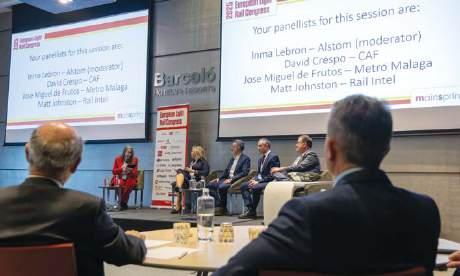

EFS allows batteries to simulate lots of vehicles in a very small amount of time. Research was carried out across 600 simulations with very positive results achieved using 50% of capacity. Batteries to top up vehicles have proved a cost-effective solution for energy management on metros, trams and e-buses.
Attendees enjoyed an organised technical tour to both the Metro Malaga simulator installed by Avansim from the UK, and the depot where the control room and banks of solar panels are housed. Then followed a busy networking reception at the La Pergola restaurant overlooking the Bay of Malaga.
Solar panel success
A four-strong Metro Malaga maintenance and data engineering team began the second day of the congress with a session on technology, efficiency and innovation to improve services. Being Spain, there is a lot of free sunshine to be harnessed, and Alvaro Raya talked about the 1850 solar panels at the depot, many of them on a slope, that are supplying over a quarter of the energy required. Jose Caballero continued with a look at the demand data from passengers, and the number of trips taken. This monitors trends, peak-time issues and passenger movement between stations. Dario Jauregui and Mercedes Martos continued the examination of data and how to make best use of it.
Marisa Machado, Head of Communications and Customer Relations at Metro de Seville, followed with a presentation on this system’s new wayfinding strategy for its 22.6 million annual users. It has a ‘mystery client’ to look at the quality of service from an anonymous perspective, and customer journey analysis looks at the entire process of making a journey.
It is known how important it is to have clear and accessible information. Colour coding was devised, as signage is in competition with lots of other things in view.
A brand new logo is now easier to see, and shares features with other metro systems in the Andalucian region.
Andrew Godfrey, Business Development Manager from Spanish company ACC Systems, presented new technology covering Auri (Aurecast), an assistive listening device. This is for hearing aids, headphones, ear buds and hearing loop systems such as those in taxis, at ticket counters, airports and theatres. All equipment needs to be A&T (Aurecast and Telcoil) compatible, and with this information the company looked at 1.8 billion Bluetooth single-mode devices that

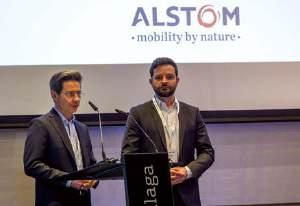
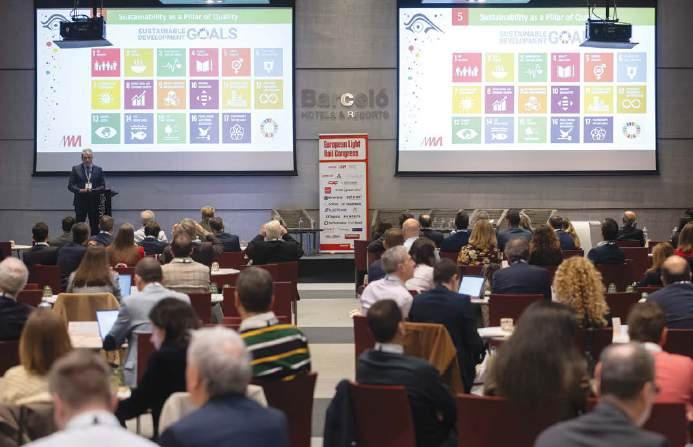
were shipped in 2024, 3.5 billion devices this year, and rising to an expected 5.5 billion by 2028. It’s an altogether great example of innovation.
Raul Parra, Project Director of Metrotenerife, gave an upbeat talk about the planned light rail expansion on Tenerife, which currently has a two-line, 16km (tenmile) system with 25 stops and 26 trams. There are ambitions to expand lines 1 and 2, construct new lines 3 and 4, and for line 3 to have a second section to connect the north and south of the island. International Business Development Manager Teresa Benet described the driver assistance system Simove; Viamovil, a paperless ticketing system; and Remove-In, ArcelorMittal’s insulating chamber for speedy track renewal that reduces service disruption.
Richard Briggs, Project Director of Mott MacDonald UK, focused on innovation in light rail and also took a look at bus rapid transit, tram-train, city bus networks and Very Light Rail. Affordability of course influences new builds, and although the UK is perceived as expensive compared with other countries, this is not always true.
Challenges include coping with planning delays and inappropriate standards. Planners and engineers are often great at developing technical solutions, but not so good at considering users and communities. The trends we are seeing in the global transport sector include a move towards staged delivery to create affordability, more focus on integration and customer experience, and of course decarbonisation.
Besançon in France has been one of the lowest cost urban tramways built in recent years by using simple, standard designs, completely with overhead wires, with cars being banned to avoid costly street designs and utility companies bearing the costs of moving and upgrading their assets. This results in far fewer being moved unnecessarily. A range of digital tools is being used by the company including constraint and risk mapping, scenario development, 4D phased modelling, and construction and operational logistics.
On the afternoon of day two, Santiago Molina, Tranvia de Murcia’s Technical Director, explained his Spanish city’s inclusive mobility offering. The system opened on 28 May 2011, and 11 Alstom Citadis trams carry more than eight million passengers a year. Anyone can travel independently because trams are affordable and safe. There is equal access to public transportation irrespective of age, gender, economic or social status, including ethnic minorities and people with temporary or permanent vulnerabilities or disabilities (physical, sensory or cognitive).
The city’s economy is also improved by facilitating workforce participation for people with mobility impairments and for the environment. Encouraging people to use public transport reduces car dependency and pollution. There are barrier-free pathways, level boarding platforms, clear and adaptive signage, high-contrast colours, braille and audio guides. As well as being easy to board, the vehicles have wide doors,

reserved spaces for wheelchairs and strollers, and priority seating.
Technology is also reshaping public transport through accessible mobile applications used in planning, contactless payment systems, reducing accessibility barriers and AI-powered personal assistance, all helping passengers with disabilities. They also offer effective signage and communication systems, multimodal information, visual, auditory and tactile formats, high-contrast digital screens and voice announcements, and accessible stop or emergency request buttons. Tranvia de Murcia also uses Navilens, a QR-style code placed at stops for the visually impaired and blind. When used via a smartphone, it talks to customers and guides them safely on and off the trams.
Ruben Ripoll, Railway Technical Director Pandrol (Spain), gave a presentation on acoustic comfort and environmental care, talking about rail solutions for urban rail. Pandrol offers a whole range of products in this sector, including clips and fasteners for concrete sleepers and blocks, baseplates, and under-sleeper pads.
The company focuses on reducing greenhouse gas emissions by 25%, using photovoltaic panels and recyclable materials. SD clips improve installation ratios, thanks to their capacity being pushed on when they are preassembled on the sleepers. The SD product range improves track stability due to the increased contact area between the clip and the rail. The sleeper also has better stability due to the contact point in the outer part. This solves ballast entrapment in ballasted track that can cause clips to break. The improved sealed screw insulator avoids dust or impurities coming into the dowel, thereby avoiding damage to the sleepers.
The Autodriv automated screw-on technology offers increased installation speeds and efficiency, maximised track availability, a higher construction rate with reduced downtime, enhanced worker safety, and reliability.
The subject of embedded rail was also explained. QTrack offers continuous rail support, vibration mitigation and stray current insulation, all integrated in the fastening system suitable for light rail, metro, and in depots, tunnels and ports.
Andrew Grant, Business Development Manager of IHF Digital from Edinburgh, Scotland, UK, used his speaking slot to talk about using his wearable ‘tech’ that monitors safety and fatigue monitoring. Baseline is a two-tiered device and hub that provides real-time alerts.
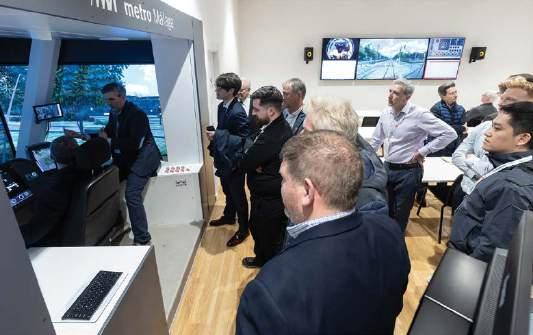
It detects heart rate, movement, skin temperature, oxygen saturation, ECG information and galvanic skin response. The hub connects via Bluetooth, and data is sent securely to the cloud. It works when a tram driver, for example, puts on the wearable technology; information transmitted to the hub is gathered via Wi-Fi and sent to the cloud. The algorithm generates alerts with an amber or red warning that trigger a conversation or intervention, according to company protocols. A green warning light signifies that the driver is awake and alert. Action, if needed, can be taken from the data.
This equipment has undergone comprehensive proof of concept testing and secondary independent analysis. A trial has been used to identify fatigued tram drivers, and was 98% accurate. There were two
“The trends we are seeing in the global transport sector include a move towards staged delivery to create affordability and more focus on integration.”
visually observed instances of napping for a few seconds. IHF Digital now intends to partner with two pilot sites over six months in Edinburgh and Debrecen (Hungary), with between 50 and 70 live participants across multiple transport modes (tram, bus and trolleybus). This will facilitate entry into non-rail EU sectors, followed by a full international roll-out.
The presenters from Ontier (Spain) outlined breakthroughs in energy self-consumption for light rail. Pablo Enrile Mora-Figueroa and Victor Artola Recolons spoke about sustainable management and reducing carbon footprints, showing how they deliver massive public health benefits.
A big challenge currently is the volatility of energy prices, and stability can be achieved by reducing reliance on national grids. For this to happen requires a system to generate its own energy and share it with other customers. A surplus can also be injected into the grid. The compensation model (bill discounts) or market sale requires an access contract and communication with the grid operator.
If there is no surplus, no energy is fed into the grid, and the lack of need for an access contract means a much simpler administrative process. Self-consumption systems require either a direct connection to the consumer’s internal network, or a private power line. The same transformer station is connected to the same low-voltage network, and there can be a distance of up to 500m between the generation and consumption points. This can be up to 2000m for a photovoltaic system if it is installed.
The challenges of self-consumption include infrastructure and space limitations, urban constraints, grid integration issues, energy storage, management, and the intermittency of renewables and high storage costs. There are also economic and financial barriers such as high initial investment, policy and regulatory challenges. To overcome these, Ontier offers technical expertise, strategic partnerships and collaboration, subsidiaries and financing, plus integration of advanced technologies.
Manuel Simon from CEMIT rounded the day off with a presentation covering rail intelligence for trams and metro systems. He covered broken rails and track faults in the asphalt, as well as track misalignments and the condition of the switches. These issues affect the maintenance and operations of course, with poor ride quality, wasted time with manual inspection and reporting, and emergency tasks needing to be carried out. All these cost money.
Cemit, which is based in Norway and Spain, captures data and analyses it through AI algorithms for the early detection of faults, and exact positioning allows maintenance needs to be worked out.
The Cemit Data Collection system (CDC) offers insights into the track condition and vehicle performance, and accurate positioning is possible by the use of GPS. The aim is to maximise network capacity and reduce maintenance costs with continuous supervision. Critical faults such as a broken rail can be identified with precision and an understanding of why they occurred, so reducing the chance of a recurrence. Cemit also provides accurate train positioning in metro tunnels, examining areas such as braking patterns and emergency stopping, wheel slides, stop positioning, and speed analysis.
As a fitting conclusion to the Congress, Malaga tourism gave the delegates a walking tour of the old part of city, and the sun shone for the first time that week.
Now, it’s full steam ahead for the next European Light Rail Congress in Tenerife in 2026.
Listening to safety concerns from your frontline can highlight unknown risks or unsafe situations. They can share with you what’s really going on, including whether processes and procedures are being followed in practice.
But even with the best safety systems, in the most open safety cultures, not everyone will report concerns openly through company reporting channels. They may prefer to raise their concerns with their identity protected.
As a member of CIRAS confidential safety hotline – as most UK light rail networks are – you have a safety net alongside your other reporting channels. We listen to the concerns you might otherwise miss. There could be under-reporting of safety concerns. Offering a confidential option can help to close this reporting gap.
By letting your staff know a confidential safety hotline is available, you are showing that you want to hear from them, however

they prefer to speak up. What matters is that you are listening. When people know someone is listening, they will make the right call and report their concerns.
We listen carefully and impartially to every concern, and we make sure reporters get a response, so they know they have been listened to. We are your partner in building a listening culture where everyone can be heard.
To help members raise awareness of the CIRAS confidential safety hotline, we offer
a range of resources. These are available on our website in our member resources area, or through your CIRAS stakeholder manager. Registering to our website to access your member benefits is simple – just use your work e-mail address. You will find shared good practice from across light rail and other transport sectors, as well as videos, posters, flyers and other merchandise to order. Plus, useful guides to promoting CIRAS and how to respond to our reports to get the most from your membership.
Thousands of organisations in the transport sector are members of CIRAS. We build a strong listening partnership with our members to improve safety. Our confidential safety hotline provides extra listening to help staff make the right call and report their concerns even when they feel they can’t use other channels. When we listen, we learn.
Learn how you can build your listening partnership with CIRAS at ciras.org.uk/rightcall.

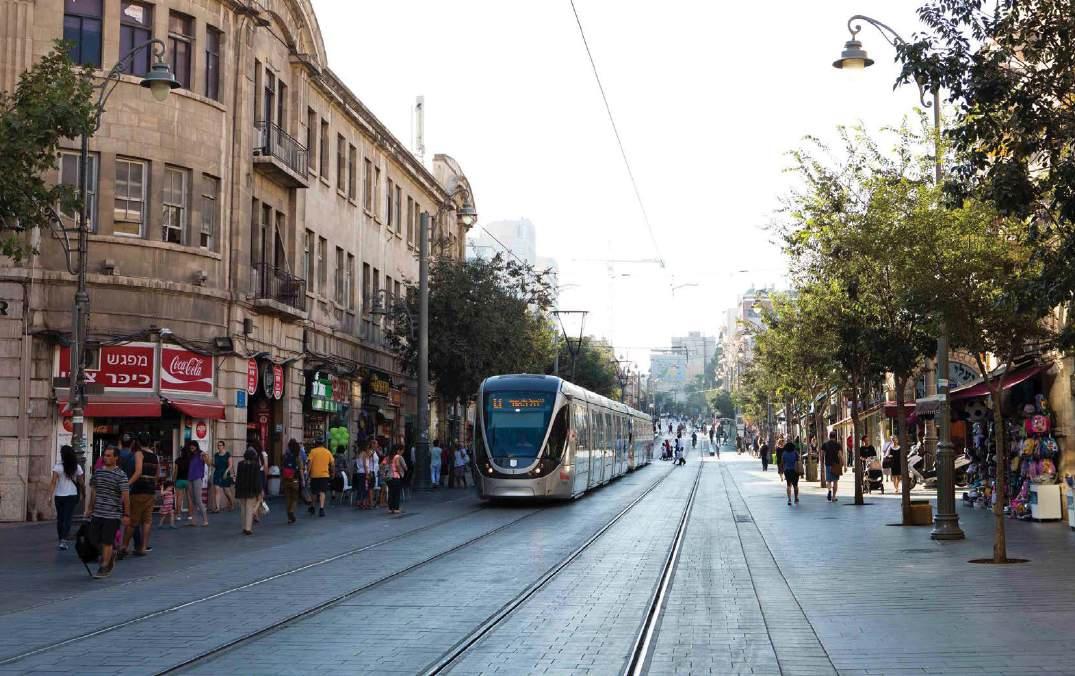
noa Tzur and itay levi of Jerusalem Transportation masterplan Team (JTmT) explain how israel’s capital city has embraced light rail, and is looking forward to large-scale expansion.
Anew light rail milestone was reached in Israel’s capital of Jerusalem on 27 February with the completion of the important north-south Red Line corridor from the northern part of the city – Neve Yaakov and Pisgat Ze’ev – to Hadassah Ein in the south west.
It follows the successful completion of all certification and safety tests and obtaining the necessary approvals to operate 12 new stations on the extended 22.5km (14-mile) route. There has been criticism of widespread cost overruns, and it will be interesting to see how many new passengers are added to the 180 000 already carried each day.
It is opportune for TAUT to conduct a fresh review of Jerusalem’s continued efforts to improve public transportation, increase accessibility, reduce traffic congestion, and improve the environment.
Jerusalem is roughly 4000 years old, and its unique status as a religious centre and place of multi-faith pilgrimage means
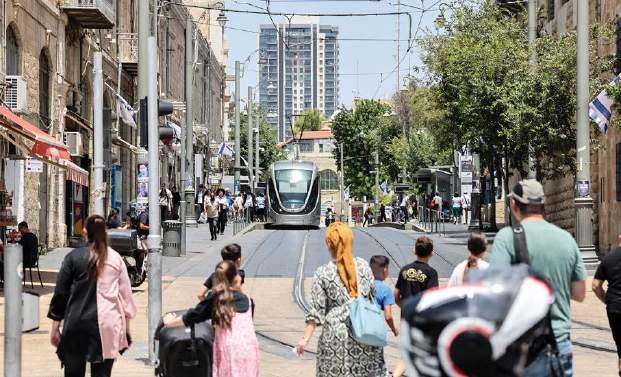
that it has perhaps suffered more upheaval than anywhere else in the world. It is home to three major monotheistic religions, Judaism, Christianity, and Islam, and the urban area covers over 126 square kilometres (46 square miles).
Transport in Jerusalem generally is complex and unique due to the city’s hilly topography, the density of construction in its historic sections, and the large, diverse,
population. The city is situated on the central mountain ridge of Israel, along its watershed line between the Mediterranean and Dead Sea, at an elevation of 570–857m. Most of the neighbourhoods are built on hills, with valleys and wadis between them. Jerusalem completely relied on urban buses, taxis, and private vehicles until 1 December 2011, when the first light rail line opened, forming the initial cornerstone
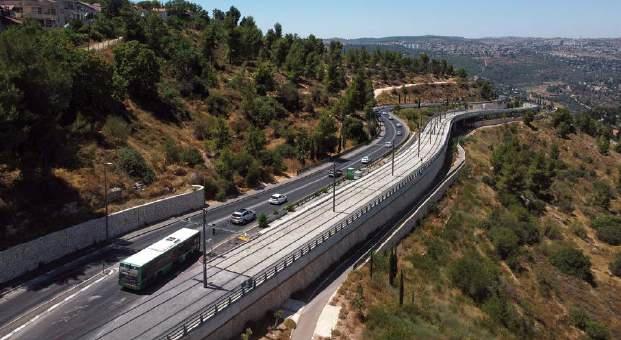
of an intended large and comprehensive public transport network, running from the city centre to Mount Herzl in the south and Mount Scopus in the north.
The construction programme was not an easy one, and after a host of teething troubles, services finally commenced 35 months after the intended launch date. There had been a shortage of trained staff, signalling was not compatible at road intersections, the air conditioning did not function on the initial 21 Alstom trams, automatic ticketing failed to work, and there were also electrical and
communications problems. End-to-end journey times of 80 minutes were twice what had been promised, so passengers were compensated with free travel.
All that is now in the past, and so are the events of July 2014 when unrest in the Arab areas of Beit Hanina and Shuafat included rock throwing, dislocating services and damaging two-thirds of the tram fleet.
Looking ahead, seven additional light rail lines are to be developed to create the total network, which is the first of its kind in Israel.
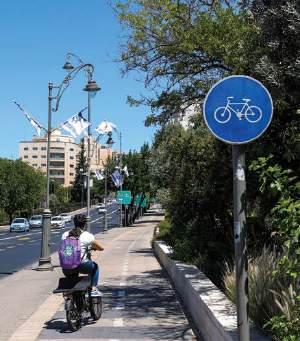
Also to be considered is the integration with inter-city buses, which primarily arrive at the central station at the western entrance to the city. The national railway also meets up here, the one active station in Jerusalem. It is positioned 80 metres below ground on a separate underground alignment, and forms an interchange for people to continue their journey using other transport modes.
According to Israel’s Central Bureau of Statistics, Jerusalem’s population was 997 000 at the start of 2025, and is growing at an annual rate of 1.4%. The metropolitan area, including nearby suburbs with a
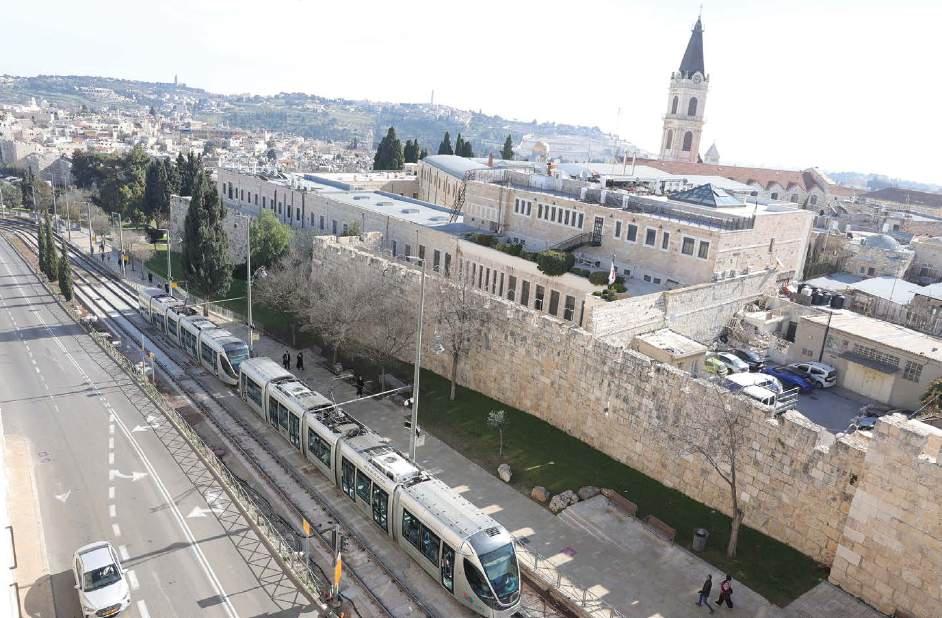
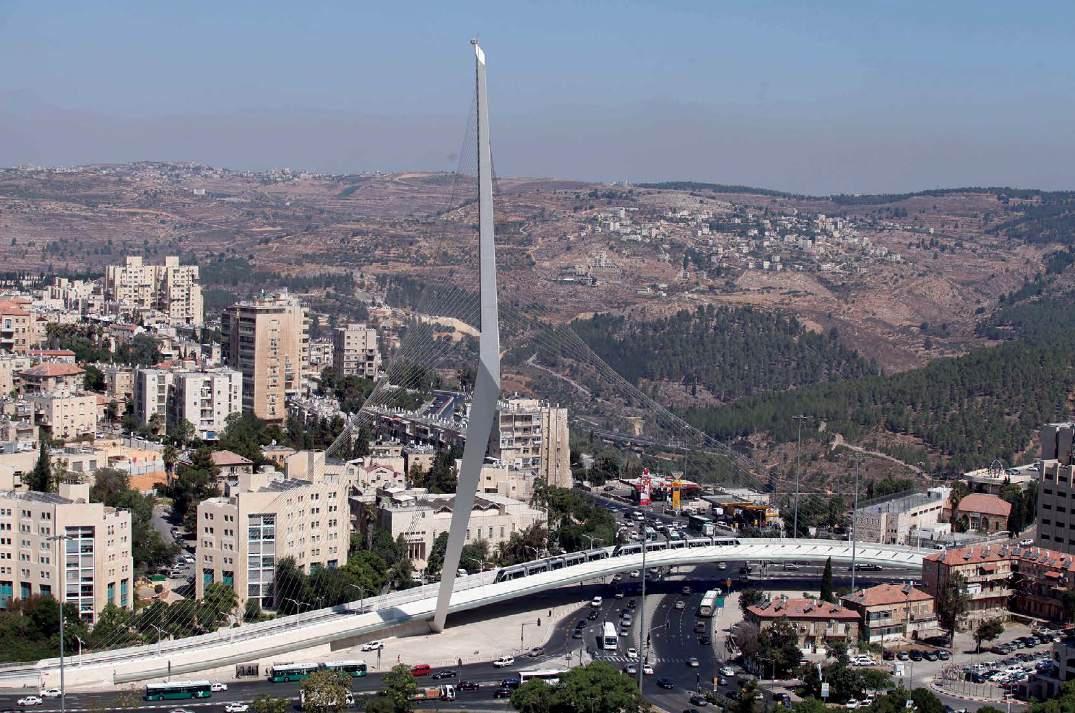
clear connection to the city in terms of employment and services, is currently more than 1.31 million. This total is only second in magnitude to the Tel Aviv-Jaffa metropolitan area.
Jerusalem is characterised by its diverse population. In the city centre, west, and south, as well as in the city suburbs, most people are secular and traditional. There are, however, unique neighbourhoods where predominantly ultra-Orthodox and Orthodox groups have become established, and the eastern and northeastern parts of Jerusalem are primarily Arab.
The average monthly wage is lower than the national average, which is why many residents rely on public transport on a daily basis.
The Jerusalem Metropolitan Area is the only one in Israel where an organisation exists to integrate all urban transportation activities, administer the road network and operate public services.
In 1968, the Jerusalem Transportation Master Plan Team (JTMT) was established to improve travel in the metropolitan area and contribute to the quality of life and the environment for both local people and visitors. The team examines development processes and changes in the urban space in both the short and long term, develops plans, and ensures that they are implemented.
JTMT is a joint body of the Israeli Ministry of Transportation and the Jerusalem municipality. It is skilled in transportation and civil engineering and urban planning, and its activities are carried out in
cooperation with many entities, including government, public bodies, community leaders, operators and professional associations.
The team is entrusted with planning, developing, and controlling the light rail network in Jerusalem, as well as planning and expanding cycling and pedestrian routes.
The grand plan is to reduce dependence on car use. The team aims to create a preference for public transport, so that in 2025, 40% of journeys in the metropolitan area should not be on rubber tyres. By significantly reducing traffic volumes, congestion will drop significantly, and environmental quality will go the other way. This is being achieved by allowing every resident to be within 500 metres of available and reliable public transport.
In the early 1990s, it was already clear that a comprehensive future solution was needed for the worsening traffic problem. All estimates spoke of increased construction density, higher vehicle ownership, and a growing shortage of parking spaces.
In short, there was no suitable public alternative to the use of private cars. More and more abandoned the buses, but in the congested city centre, 450 buses were crowded at peak hours. Journey times became slow (14km/9mph on average), waiting times and delays at stations increased, and noise and air pollution became unbearable.
Thus, the idea of light rail was conceived as the answer and the task assigned to the JTMT. The clear advantages were seen as being better traffic flow in the city centre (high
capacity, traffic priority); urban regeneration and accessibility; being quiet, safe, and non-polluting, with a four-minute service frequency in the peak.
Light rail’s success relies on a combination of several factors. It operates on central routes. Buses are complementary feeders, serving areas where trams do not go, including the outskirts of the city, and they transfer people to ‘cheek-to-cheek’ interchanges.
Almost a decade ago, a policy change completely altered the role of bus transport in Jerusalem. For years, one company –Egged – was the sole operator in the city, but this is now divided up between three businesses. Egged continues to control the southern part of the city, while Superbus runs into the centre, and Extra looks after the north. Competition has seen service levels improve, and this will change again before 2030 when bus franchising next goes out to public tender.
By then, the goal is for 40% of all buses travelling on city roads to be green – powered by gas and electricity. Today, a total of 700 buses run at peak times. In the last ten years, the distances covered have doubled, and direct fast services have also been added to central areas of employment.
Preparing for the creation of the first light rail line, the government decided to advance the project through a Public-Private Partnership (PPP). The costs incurred by the public sector were divided between the Ministry of Transportation and the Jerusalem municipality on an 80:20 ratio. The contract
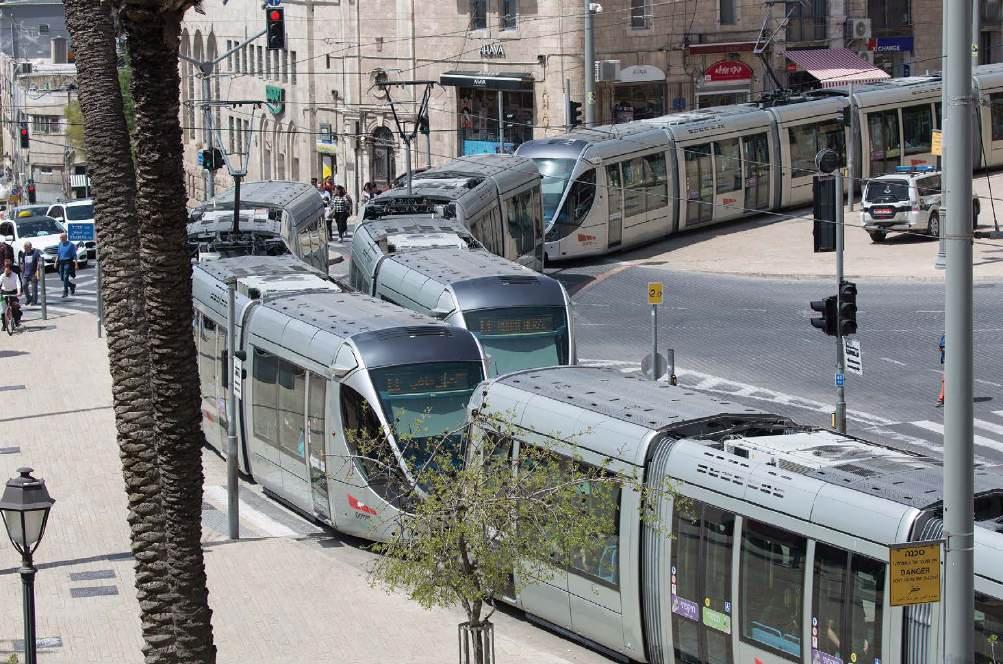
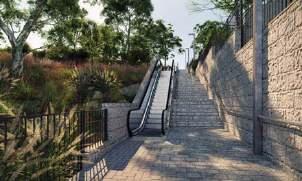
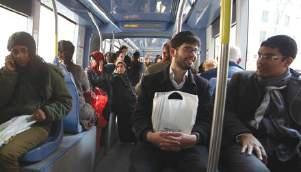
winner was promised a grant of NIS1.4 billion (EUR3.1 billion) to be paid at the end of construction. The agreement included creating priorities at junctions, a monopoly on rail travel routes, and security in case of lower-than-expected passenger numbers. Setting fare rates remained the responsibility of the Ministry of Transportation.
The public sector was tasked with planning, transferring infrastructure, evacuating properties along the rail route, compensating landowners, diverting other public transport, and establishing park-andride facilities.
The private company’s contract was for 27 years after completion (estimated to take three years), as well as track-laying and electrical and signalling installation, plus purchasing rolling stock.
Activity on the first route, Red Line, began in 2000, to ultimately connect the northeast to the southwest of the city and the central bus station. Its length is 13.8km (8.6 miles), with 23 stops, serving 150 000 residents.
Infrastructure works were carried out by the municipal company Moriah, while the operator chosen for laying the tracks was Citipass. Test rides began in August 2011, and trams entered full operation after four months. Four years later, when Citipass was expected to lay the tracks to extend the Red Line, the company announced that it was not interested in doing so, leading the Ministry of Transportation to put the system out for a new tender. It was won by Kfir, which became the light rail operator in April 2021.
Lessons had been learned, and an overarching transportation strategy was developed to streamline risk allocation between the private and public sectors, emphasising the advantages and capabilities of each of them. The public sector no longer commits to non-competition and security networks.
At a higher level, the state of Israel provides security and addressing of incidents.
The incentive mechanisms for private winners have also changed, ensuring a payment of 3% of the actual collection (redemption) from ticket sales. There is a fixed incentive payment for each validation carried out on light rail above a threshold of 75%, a payment of 80% of the actual collection volume per month from increased charges (fines), and extra money according to the distance travelled.
The Red Line has contributed significantly to improving the city’s landscape and revitalising the city centre. For example, the cantilever cable-stayed Chords Bridge was built in 2008 at the western entrance to allow for smooth passage of the tramway. It was designed by the renowned international architect Santiago Calatrava and has become one of the city’s prominent landmarks.
A strategic decision was made at key junctions (such as at the Pat Intersection and Zalman Shazar Street) to grade-separate the light rail line, with all vehicles diverted below ground level to reduce conflicts in the city centre. Traffic along the light rail route was halted, and entire streets turned
into pedestrian walkways. This not only beautified whole areas, turning them back into bustling hubs full of people, businesses, hotels, restaurants, and cafes, but also contributed to a substantial reduction in air pollution levels (from an average of 311mcg/m3 of nitrogen dioxide at Jerusalem transportation hubs in 2001, to 24mcg/m3 in 2013), earning the AB Plan team a Light Rail award in 2015.
The Red Line operates from 05.00-00.45. Between the hours of 07.00-18.00, trams run at an average interval frequency of six minutes. During the Sabbath (Friday afternoon to Saturday evening), no other public transport runs.
In the peak hours, Red Line has demand for high service levels, and there is extensive monitoring of its performance with intensive supervision to ensure compliance with service requirements (KPIs), with financial penalties for deviations from the required service level.
End-to-end travel time was up to 50 minutes in 2013; this dropped to 44 minutes in 2022.
Passenger volume has also increased steadily alongside this – from 33 million annually in 2012, to 46 million in 2023. This figure almost matches the pre-COVID peak of 47.8 million.
A satisfaction survey on light rail was conducted in 2023 by the Transportation Planning AB Unit, which found that the majority of Jerusalem residents are satisfied with the new mode of public transport.
Last year, upgrades were made to the stops, ticketing and enforcement, and the Passenger Information System (PIS). Upon completion of the Jnet network, which includes five lines, 114 new cars will be operated in addition to the existing 46.
What’s next?
The extension of the current Red Line to the east and the west, with a connection to the city’s major hospital, has just reached its conclusion.
The entire Jnet network is intended to include five routes, including the Red and Green Lines, operating along a 27km (17mile) route with 52 stops. It will have 80 trams carrying around 350 000 passengers
“Planning new routes is not easy in a city like Jerusalem, with its ancient streets, narrow roadways, and restricted rights of way.”
per day, and the estimated total cost is NIS12 billion (EUR2.7 billion).
The consortium selected to establish and operate Jnet is Kfir, which is owned by Israel’s Shafir Engineering and Spanish company CAF. The planned start of operations for the 19.6km (12.2-mile) Green Line, begun in 2018, is perhaps only a few months away. It will connect the campuses of the Hebrew University of Jerusalem and run via Pat Junction to Gilo, with 35 stops. It is hoped that daily ridership will be around 200 000.
Blue Line comprises three sub-routes –Blue, Azure, and Purple. The builder and operator, JTRAIN, was selected in autumn 2023. The route is 31km (19 miles), of which 2.5km (1.5 miles) is underground, with 53 stops, and 66 trams carrying around 245 000 passengers per day. The project has a budget of NIS16.5bn (EUR4.1bn), and it should be opened in stages between 2028-31.
In addition to this, two more lines are at the advanced planning stage, but have not yet received the necessary statutory approvals.
The Yellow Line will run from the old city to the Israel Museum (6.5km/four miles), with 12 stops. The construction cost is estimated at NIS1.1 billion (EUR250 million). No start date has been determined.
Brown Line will run from Atarot to Umm-Lisun, and the likely cost is NIS3.5 billion (EUR880m) for the northern section of alone. It could be 16km (ten miles) long and have 28 stopping places.
Four maintenance depots wil eventually be required. They are Givat Hatachmoshet (French Hill), recently expanded for the Jnet network, and Depot 25 is also for its operation. Nave Ya’akov will play a similar role, while Malcha will be established for the Blue Line.
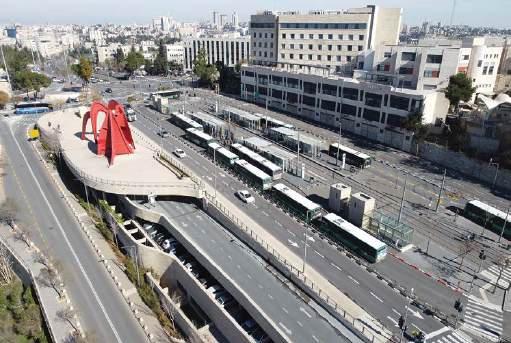
Another key aspect of the transportation revolution in Jerusalem is the major expansion of the bicycle and walking trail network. The city is built on hills and valleys, so travelling on two wheels can be quite a challenge. However, there are only about 30 rainy days per year on average, so it is definitely possible to build a network for both regular and electric bicycles.
Until 2020, there were roughly 49km (31 miles) of bike paths in the city, but this has more than doubled, and an additional 25km (15.5 miles) are in various planning stages. According to the Urban Bicycle Path Master Plan, there will be close to 300km (185 miles) throughout Jerusalem by 2030.
Planning new routes is not easy in a city like Jerusalem, with its ancient streets, narrow roadways, and restricted rights of way, such as in the old city centre which was built during the British Mandate period (1918-48). Where cars and lorries have to share the tight spaces with cyclists, the speed limit is 30km/h (19.3mph).
Tracks, trams and stops are not enough to convince residents to abandon their private vehicles and use public transport, especially in a city like Jerusalem.
The hilly topography and the city’s large expanse mean that distances between places are not short, necessitating the construction of an additional supporting infrastructure to lead people to and from light rail stops, whether by lifts, escalators, bridges, or inclined walkways.
Steep terrain often results in fragmented walking spaces in many areas, hindering safe and convenient walking to nearby points of interest, including public transport and tram stopping places. The motor car is often seen as better.
Jerusalem’s light rail is a pioneering concept in Israel, and must be rated a success.
More and more residents, tourists, and visitors are opting for public transportation, which is a viable, efficient, and pleasant alternative to private vehicles. Construction work is still ongoing, and residents can expect several more years of inconvenience, but the prospect of a well-run Jnet network and the Blue Line are things to really look forward to.
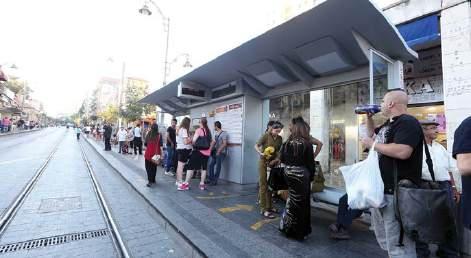


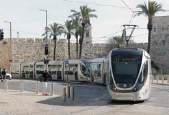


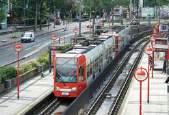


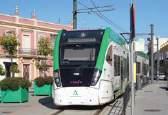


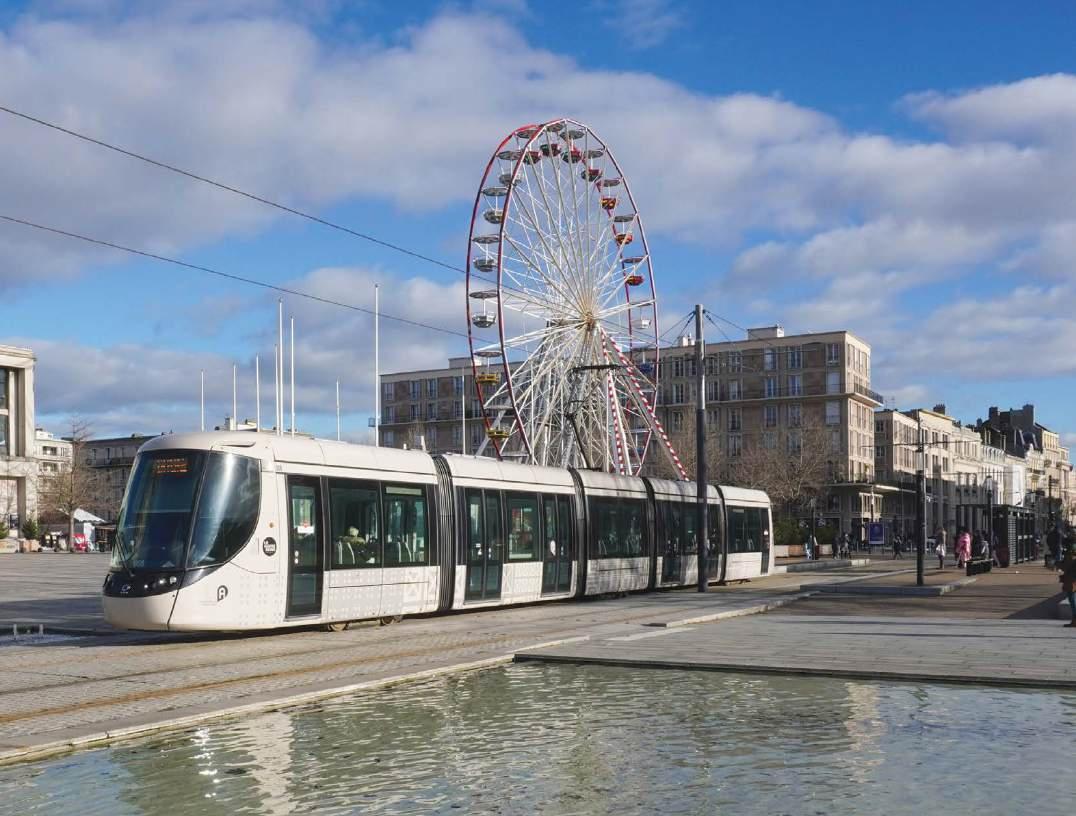
andrew Thompson visits le havre, France, which is set to double its network length in the coming years.
Located beside the English Channel along the coast of Normandy, the French port city of Le Havre is an important administrative centre with a population of
roughly 166 000. Since December 2012, Le Havre has benefited from a modern tramway, which currently features two lines and has a network size of 13km (eight miles) with 23 stops and one depot.
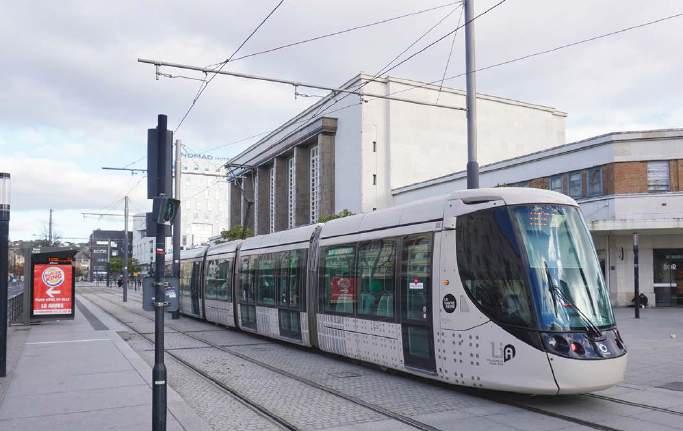
A hillside funicular is another important public transportation link, as it connects Place Thiers in the city centre with a residential district at the hilltop terminus Rue Félix Faure. First built in 1890, the funicular is 343m long and scales an altitude of 77m. Due to wartime damage it was closed from 1946-50, but in 1969 the decision was made to modernise the funicular and install new carriages with rubber tyres. Since reopening in autumn 1972, the funicular has been regularly maintained, with the last major overhaul taking place in 2021. More than 1300 passengers per day use this inclined railway that was originally known as ‘Chemin de Fer de la Côte’.
leFT: le havre's terminus railway station dates from 1932 and is one of the city buildings to survive extensive wartime damage. le havre was comprehensively rebuilt from 1945-64 and the distinctive, concrete architecture used led to the city being awarded unesCO World heritage status in 2005. The new line C extension will branch off from the railway station just to the right of the picture.
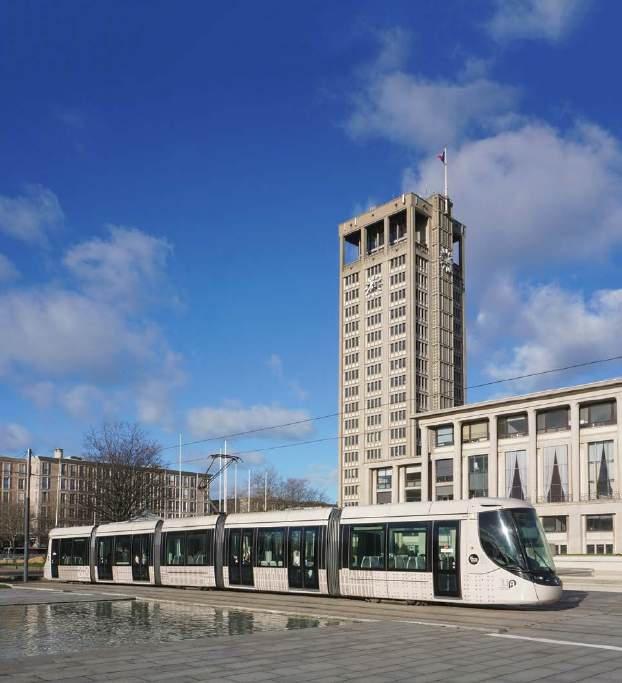

City officials are currently implementing ambitious plans to add a third tram line to the network, which is due for inauguration by late 2027. Diverging from the current trunk route of lines A and B to run south of the main railway and bus stations at Gares, line C is to serve the docks and port district before terminating at Vallée Béreult. At its other end it diverges at Université to connect the eastern neighbourhoods of Graville and Harfleur, before turning north to run over a disused railway route to the neighbouring commune of Montivilliers, with its population of roughly 16 000.
“Thanks to the significant investment that Line C represents, Le Havre will grow from one of France’s smaller systems to one of the country’s mid-tier networks.
The interurban nature of line C and its 14km (8.7-mile) length will essentially double the size of Le Havre’s tram system, while adding 17 new stops and three new Park and Ride facilities.
Between Harfleur and the Montivilliers Parc Jardin northern terminus, the region’s major medical centre at Hôpital Jacques Monod will also benefit from a new connection to the light rail network, while at Graville the football stadium Stade Océane will also have a new stop.
Roughly 50 000 passengers a day use tram lines A and B, with an additional 25 000 expected to use line C once it has been launched. During peak times, line C is expected to operate a ten-minute headway, decreasing to 15 or 30 minutes off peak or on Sundays. On the short section of trunk route shared by all three lines from Gares to Université, a peak hour tram service will be available every three minutes.
A significant proportion of the infrastructure will be laid out on a reserved right of way, including grass tracks, which have become the stylistic hallmark of French light rail design and aesthetic urban integration.
Since its opening in 2012, Le Havre’s second-generation network has been operated by 22 double-ended Alstom Citadis 302. In March 2025, Alstom was announced as the supplier for the new line C fleet, with an initial order of at least eight 33m LRVs with a capacity for 206 passengers.
Thanks to the significant infrastructure investment that line C represents, Le Havre will grow from one of France’s smaller systems to one of the country’s mid-tier networks. This follows in the rich history of light rail in the port city, which initially began as a horse tramway in 1874; the firstgeneration system would only last until 1951.
Now this UNESCO World Heritage site and its conurbation are set to continue on a path of growth.
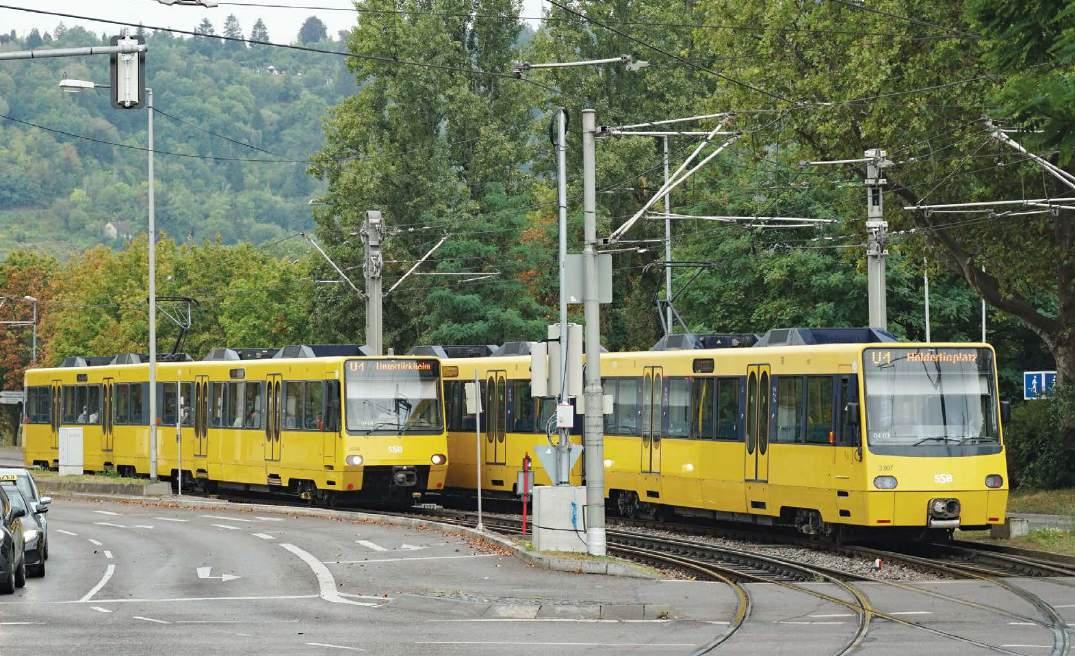
richard foster talks to Create streets’ david Milner about how tramways should be integrated into development plans to make for a better, greener way of living – and solve the UK’s housing crisis to boot.
It’s our mission to get 15 tram lines under development within five years.”
Most passionate and enthusiastic supporters view light rail as a panacea for most urban issues. But anyone with any experience of light rail in the UK would surely dismiss David Milner’s vision as pie-in-the-sky, given how difficult it is to get even the shortest of extensions off the ground.
But the Create Streets Managing Director is not coming at this from a light rail point of view. Instead, he sees light rail as a key part of solving Britain’s housing crisis.
Reg Harman and Nick Falk discussed the Labour government’s plans to build more than 1.5m new homes by 2029 in TAUT 1046. The aim is to solve a crisis whereby high prices and rising rents, coupled with too few new houses being built, means that people – particularly younger people – can’t afford to buy their own home. This has become so acute in Gwynedd, North Wales, that a 150% council tax premium has been imposed on second homes; consequently, house prices have fallen by 12%.
Building new houses is good for the economy. New research by analysis firm NERA suggests that a 1% rise in house prices reduces productivity by 0.14%. Conversely, were house prices across London to fall by 1%, it could unlock GBP7.3bn (EUR8.8bn) of Gross Added Value.
If demand remains constant, then more
new houses mean lower prices. That means that more people are able to get onto the property ladder – and that stimulates growth.
You could be forgiven for never having heard of Create Streets. The ten-strong team is made up of urban planners, master planners and a think tank. It rose to prominence last summer as one of the driving forces behind the Back on Track report that advocated the development of more light rail schemes.
The report offered solutions to the myriad problems involved in building light rail systems in the UK, from driving down the cost and working with utility companies, to devising alternative sources of funding.
But how did an urban planning firm become a passionate supporter of light rail?
“For me,” Milner says, “transport and housing – it’s two sides of the same coin. We are the same people, whether we like it or not.”
The catalyst was the discovery by Create Streets that trams could help it deliver its concept of ‘gentle density’.
“We keep seeing too many masterplans at too low density, with boxes sprawling across the countryside. Milner talks of being able to up that density to what we call ‘gentle density’, which is really not about height. It’s about terraces, it’s about mansion blocks, it’s about slightly tighter distances between the homes. It’s about looking to historic street patterns and seeing how we can replicate them.”
aBove: from a transport planning perspective, Germany offers a more integrated model that is one step ahead: tramlines are planned into residential developments from the start, so that routes are built even before the houses are in place. this means that the parking demands of new developments are lower. here, the stuttgart system is pictured near the Untertürkheim interchange in the north-eastern suburbs. Neil Pulling
By bringing houses closer together – like a row of Victorian terraces – and reducing parking and the space for roads, ‘gentle density’ allows more houses to be built in smaller spaces. To put that into context, if the authorities in the Wiltshire town of Chippenham adopted gentle density, they’d be able to build the 7500 new homes that they’re planning in 40% less space than currently earmarked. If that approach is applied to Labour’s 1.5m new homes, Create Streets estimates that it could save an area of countryside the size of the Isle of Wight from being built on. However, gentle density requires reliable public transport.
“We keep seeing so many masterplans –they might have promises of a bit of Section 106 [developer contribution] money, a bit of value capture promised to the bus service, but it gets pulled in five years. There’s no fixture to it and people are not able to live their lives like they can with rail, which is a more permanent feature.”
Heavy rail, says Milner, is “effective at what it does, but it’s quite expensive and it’s quite hard to bring new heavy rail in for new housing developments.”
Another alternative is the bus. But then Milner discovered a third option: trams.
Trams from day one
“I was on a call with Stuttgart’s chief planner and he very casually talks about how they build the tram line out to the [development]
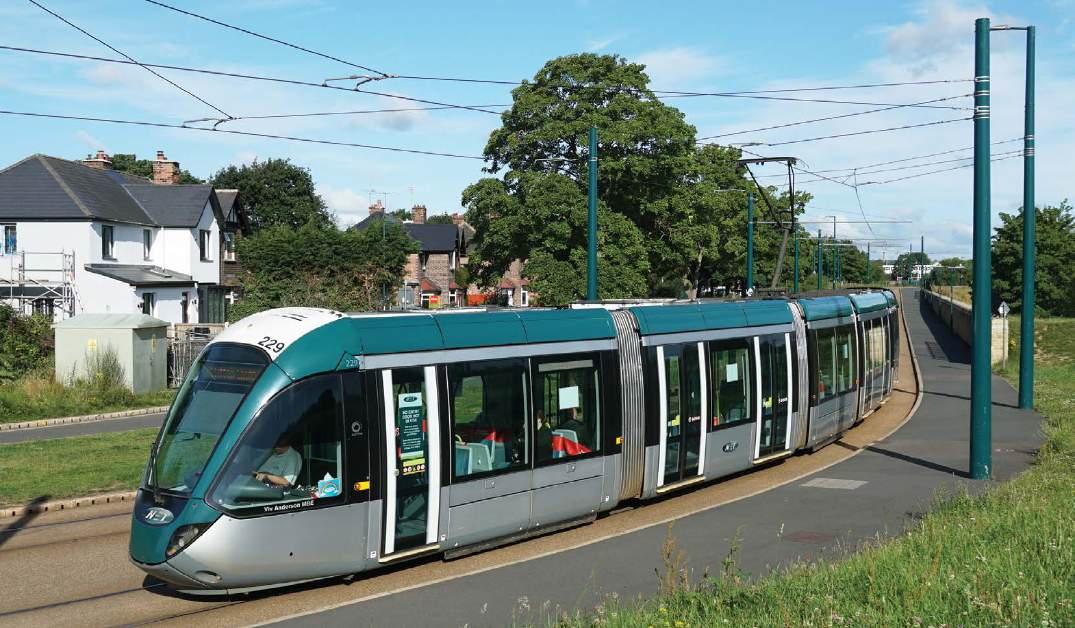
plot and you have a tram and no homes. He [said], ‘Here are the different areas and they’re all going to different developers’.
“[Developers] know what they can build, they know trams are going to be there from Day 1 and, that way, they can dial the parking numbers down. And the people buying the homes know that they can get to work in 25 minutes. Whereas you show me a masterplan in the UK where that can happen. Occasionally, we’ll build around a station or upgraded capacity.
“Light rail is a really effective but different tool kit…[that] should absolutely be exploited to deliver more homes. But also, to create the local economic conglomeration and the local economic growth effects. That’s why we’ve had this mantra: ‘It’s time for trams’.
“We’re not looking at this as ‘this vehicle versus that one, and look at the bogies on here’. It’s about place. This is about towns and cities and it’s about economic growth and it’s about green growth.
“We’ve formed a thing called Tram Network and it’s basically this mission: to get 15 tram lines under development within five years.”
How exactly might the Create Streets team make that a reality? Milner foresees a two-pronged approach.
“One is that we continue working on what legislative changes or standards changes could be done to reduce their costs. That’s the nuts and bolts, working behind the scenes, speaking with the government, speaking with stakeholders, to get this changed.
“Two is more above the surface, shouting really loudly about how trams can solve your city’s economic and health problems.”
Milner explains that transport is often the least-considered factor in any new development. In fact, he says, the biggest transport-related decision is usually where to locate a school.
In TAUT 1039, Martin Fleetwood, a consultant for law firm Addleshaw Goddard, said that transport “is always viewed by the general public as being at the bottom of the pile”. But, he said, “The local world would grind to a halt more quickly if you took [funding] from transport than if you took it away from a hospital or a school. But it’s not viewed with that level of importance.”
Put a greater emphasis on public transport, however, and Milner says that it could make the difference between building 400 homes on a site or 4000.
“That’s not being facetious. It really is that dramatic. That’s how we’re going to solve the housing crisis – or not.”
Looking from back to front
There are green shoots of optimism. The National Planning Policy Framework states: “Transport issues should be considered from the earliest stages of plan-making and development proposals, using a vision-led approach to identify transport solutions that deliver well-designed, sustainable and popular places.”
Traditionally, Milner explains, there’s “a very niche traffic modelling mechanism” whereby car production figures form the basis of a prediction of future road use. The problem is that “you end up funnelling a lot of money into what we did in the past but even more so”. That means wide roads and roundabouts.
Vision-led flips this on its head so that a plan actually starts with the outcome and then works back.
“You start from the outcome that you want. You say to achieve these health, happiness, carbon targets, back-cast and then you need to put [these factors] in place and it tends to be a lot more active travel, a lot more rail and bus and all these different versions.”
But trams still have a fight on their hands. TAUT readers and industry leaders will be quick to point out light rail’s economic, green and health-boosting credentials. However, the general public sees years of disruption, while local authorities see spiralling costs. Why spend all this money and cause all this disruption, they say, when buses can do the job just as well? Stephen Joseph, former Chief Executive of Campaign for Better Transport, calls this the ‘Alistair Darling Argument’, after the former UK Chancellor of the Exchequer who pulled the plug on several high profile tramway schemes.
Joseph said, “With the best will in the world, reserved fixed track public transport systems seem to do better and have more attraction for people to use them than buses do. Only trams have the carrying capacity. You can’t run buses at the same density.”
“I really don’t like the kind of tram versus bus argument,” Milner adds. “You only have to look at Nottingham to see that good tram equals good bus. They are different tools for different jobs. You can form a spine of a city with a tram or mass transit but you can’t get the coverage that a bus provides. But a bus finds it really hard to provide the spine.”
The biggest key to unlocking those 15 tram schemes is to convince local authorities that they can have a tram.
“If we can get their costs down per kilometre, we remove that default of, ‘We can’t have a tram, it’s too nice and we can’t have nice things in our city of under 200 000 people’.”
Starting talks earlier
Such defeatist thinking is alien in much of Europe, for example. There are several French cities of between 100 000 – 150 000 people with tramways. Milner cites Germany’s Ludwigsburg as a prime example of a smaller city – population approximately 120 000 –
that’s building a tramway. He jokes that were he to propose 15 new systems in France, he’d be met with a Gallic shrug –‘so what?!’
Discussions have to start early. For example, Create Streets has been invited to consult for the proposed Waterside redevelopment in Hull. So Create Streets is to meet the Yorkshire coastal city’s councillors and senior officials, bringing along experts from Campaign for Better Transport plus “one of the tram providers” to act as technical consultant.
Milner hopes to have similar conversations with other similar towns and cities, such as Oxford, Bournemouth or Bristol, “to see if a tram is something that would be interesting to them” – but only when Create Streets is invited to do so.
“[We could] explore what lessons have we learned from France, what lessons have we learned from (Phase 1)… just to start that conversation. And get the right people in the room with the right political champions, and build the right groundswell of support so that it almost creates that demand.
“I want to bring this topic to party conferences and city conferences, to conferences on health, obesity, on economic growth. We need to punch out of the industry and talk to people who are creating cities and towns. And that’s our network.”
Solving the housing crisis – via the construction of new tramways – arguably starts with public perception. And perceptions can change, as Martin Fleetwood said in TAUT 1039: “Edinburgh is a wonderful case in point because it took so long… [and] cost a lot more than anyone was expecting. People were going, ‘Never ever will we have a new tram system, do not even speak of it.’
“Now, we have the extension to Leith, there’s going to be a north-south line and people are saying, ‘When’s the next one?’”
Says Milner: “We need to take people on a journey [so that they] will understand why you are building this shiny new tram.
‘That’s expensive. The GP [doctor] is underresourced’. “But if you said, ‘houses are so unaffordable, eight times [your] salary. If we build a tram, we could protect our countryside, because you could build more homes on this land and save those fields that you’re campaigning on there. We’ll be able to create some homes for you and your children’.
“And, by the way, [we’re going to] pay for 50% of the capital costs because we’re capturing it from the value of these homes. And we’re going to reduce congestion by X% because more people are going to go on the tram so that the roads are freed up for people who actually need them the most.
“Then I think we can resonate with the public. That’s our hypothesis as to why we’re relevant and why we think we’re needed as an organisation.”
BeLoW: Create streets is due to meet officials from hull, UK, to explore whether a tramway could benefit the city. other cities that could benefit from looking at tramway options include oxford, Bournemouth and Bristol. 43 Clicks North, Unsplash
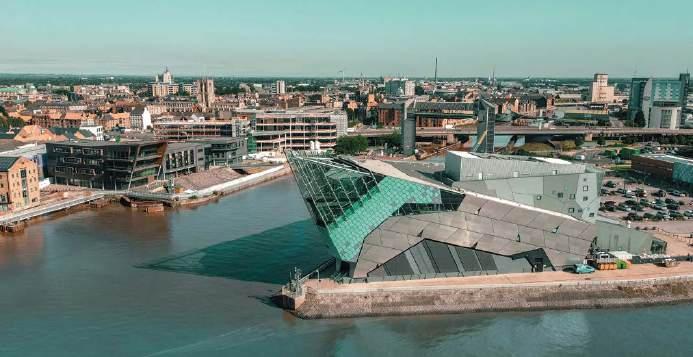
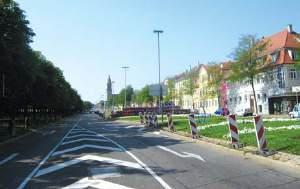
aBove: While the size of the population of a town/ city seems to be a restrictive requirement for a tramway in the UK, no such rules seem to apply in europe. Ludwigsburg in Germany is a city of just 120 000 people, yet a light rail system was approved in 2022 with construction due to commence in 2026. Alexander Johmann, Flickr, CC BY-SA 2.0
riGht: Besançon in france (population 120 000) managed to build a modern tramway for half the cost of comparable networks. here, 815 climbs towards allende stop: west of here the line’s route weaves to serve a mix of housing and educational/medical establishments. Neil Pulling
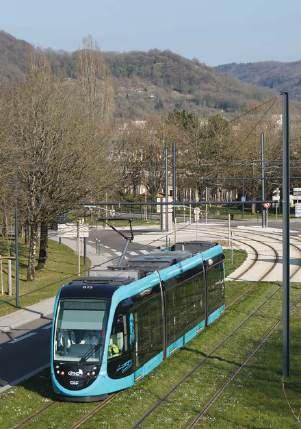
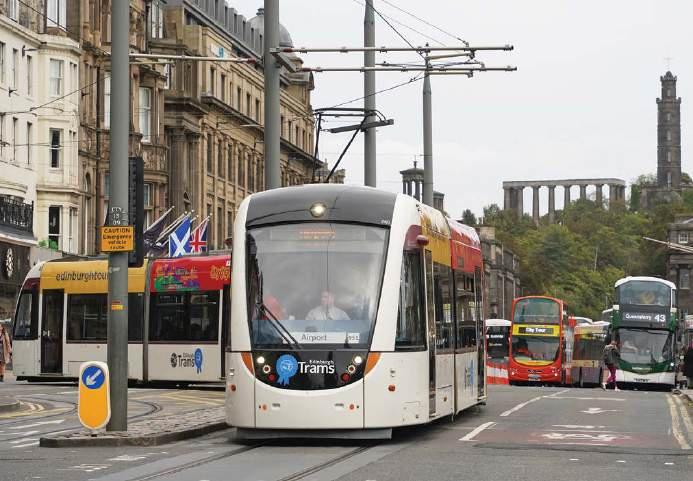
Andrew Thompson explores the Czech capital’s tramway as it marks its 150th year in 2025 with a flurry of extensions.
Prague
czech re Public
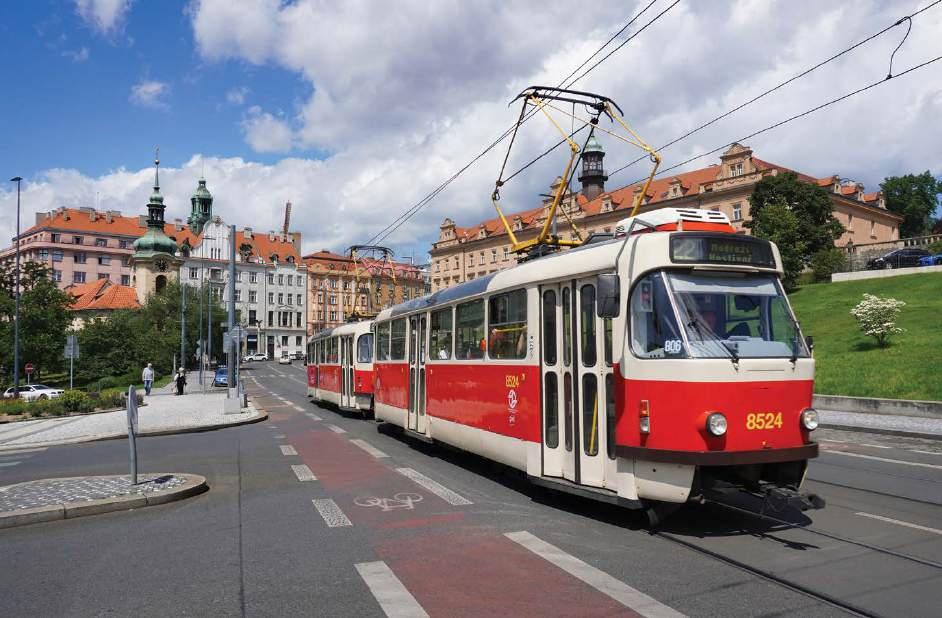
as one of the celebrated cities of Central Europe, Praha (Prague) has one of the world’s great public transportation systems and is currently the fastest-growing tramway on the continent. With an emphasis on comfort, convenience and seamless interchange, the Czech capital’s multimodal transit system has recently seen the reintroduction of trolleybuses, plus a new and efficient BRT link between the metro and the airport terminals that opened in March 2024. This service is intended as a stopgap measure until the long-awaited railway line to Vaclav Havel Airport is launched in the early 2030s. Since summer 2021, no fewer than eight separate extensions of the tram network have opened, taking the system to its current size of about
150km (93 miles). It won’t stay at that scale for long though, as another half dozen projects are already at an advanced planning or early implementation stage. This includes a 2.3km (1.4-mile) branch to Komo ř any due for inauguration by 2029, which will create a new southern extremity for the whole system on the east bank of the River Vltava. At the northern end of the network, the first interurban route into the neighbouring Central Bohemian region will break ground in 2027 and should be completed two years later. It will feature a 5.2km (3.2-mile) line from the current Vozovna Kobylisy terminus of lines 17 and 24 to the suburban towns of Zdiby and Sedlec, where a large Park and Ride facility will be built to encourage modal shift. New eastern branches to Malešice (2.2km/1.4 miles) and Habrová
ABOVE: Tram line 22 is one of the most popular in the city and covers a route from the northwest to the southeast. As it also serves numerous points of interest along the way, it is boosted by tourist line 23 that serves most of the landmarks and which follows a shorter section of line 22. Line 22 is operated with both modern and classic vehicles, as seen here with a high-floor set of T3 trams led by 8524 passing through the attractive Vršovice district.
(2km/1.2 miles) on the grounds of the former Žižkov freight yard, as well as an extension from Malovanka to the giant Strahov stadium (1.5km/0.9 miles) on the west bank of the river are ready to break ground soon and scheduled to open in 2027.
In the city centre the landmark project is the reintroduction of trams on the main square Václavské náměstí, where shovels are currently in the ground and initial milestones were achieved in autumn 2024, when the first new points were installed following a multi-month engineering block in summer 2024. This will enable the future divergence of trams from the current light rail corridor that cuts across the lower part of St. Wenceslas Square to reach the National Museum at the top of the square, and then link up with the existing lines 11 and 13 in the
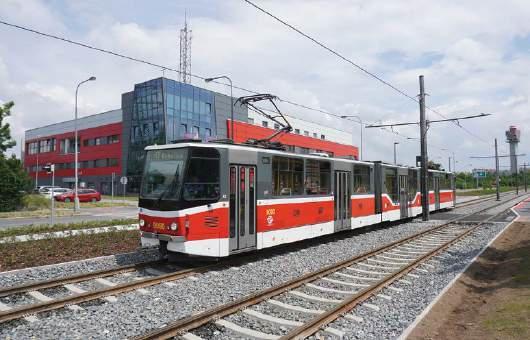
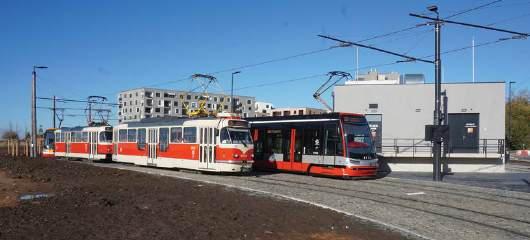
ABOVE: The 2.2km (1.4-mile) extension from Divoká Šárka to Dědina opened in October 2023 and is currently served by lines 20 and 26. from this northwestern end-point of the tram network, a future extension to the railway interchange at Dlouhá Míle is planned, with a possible extension to the nearby airport. for now, the Dědina branch serves housing estates and new residential developments, ensuring high demand. In the foreground is one of the modernised Tatra T3R.PLF cars with low-floor section. from these tandems, typically only the front car is low-floor, as seen here with 8293 leading 8384.
Prague’s contemporary tramway fleet consists of c zech-built cars only, and currently features over 780 lrVs. With the exception of the 100-plus double-ended Tatra KT8D5.RN2P, the rolling stock is predominantly single-ended and turning loops are typically built at new, permanent termini. e ven after the withdrawal of the 1990s-era Tatra T6A5 in 2021, the older and more iconic T3 soldier on in different variants. While the non-modernised heritage cars are used on tourist line 23, the T3M and T3R.PLF are deployed solo or double-headed on busy trunk routes around the city. For the night lines 91-99 they run as single sets. e ven more diverse is the deployment of heritage cars on the museum lines 41 and 42, which typically see the use of early 20th century r inghoffer stock, although sometimes also feature appearances by the oldest Tatra variants, especially the Pcc-derived T1 or T2. These are based at the public transport museum Vozovna Střešovice, which is located in convenient proximity to Prague c astle and served by tram lines 1, 2 and 25.
TOp LEfT: The praha network is designed for single-ended LRVs and most lines are fitted with turning loops. In order to maintain operational flexibility in case of engineering works and to reverse vehicles on temporary points, Dpp also has a large fleet of modernised Tatra KT8D5.RN2P with retrofitted low-floor centre modules. At the same time, these are the only double-ended vehicles in the tram fleet. In recent years, several new tram routes have been fitted with temporary termini, while extensions are built in different phases over the course of several years. These include the endpoints of lines 19 at pankrác and of line 17 at Libuš. On 9 June 2023, Tatra KT8D5 9090 has just left the new stop Hasičská stanice Modřany along the 1.8km (1.1-mile) extension between Modřany and Libuš in the south of the city, which opened in late May 2023 with four new stops. In the background the local fire station can be seen, after which this stop is named.
BELOW: Sporting the new ‘pyjamas’ livery of prague’s integrated transport authority pID, the single-ended Škoda 14T with its distinctive styling from the porsche design studio stands at the particularly wide, three-track terminus loop at Slivenec. This southwestern extremity of the prague tramway opened in October 2023 as a 500m extension of the previous 1km (0.6-mile) extension from Sídliště Barrandov to Holyně, which was launched in April 2022. The Slivenec terminus is currently served by lines 4 and 5.
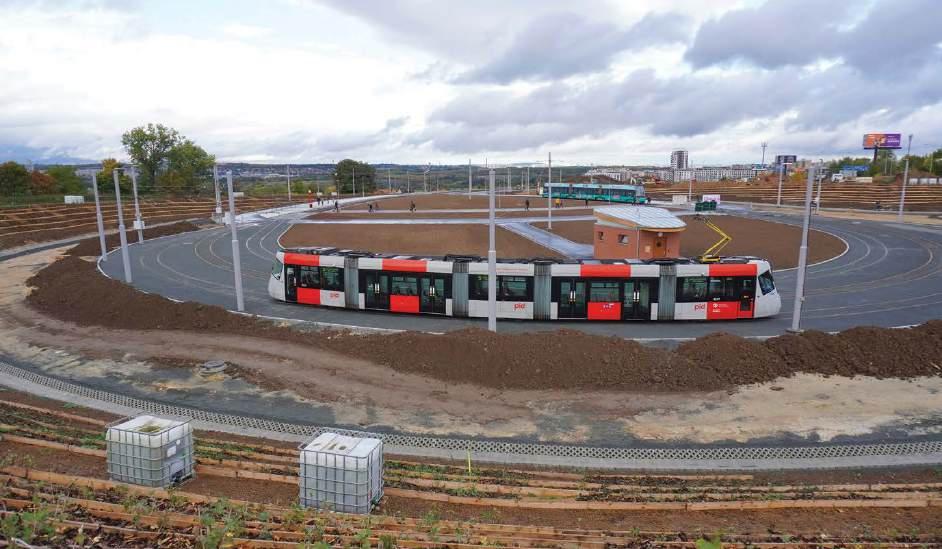

Dlouhá třída Strossmayerovo námĕstí
Vltavská Štvanice Tĕšnov Bílá labut Masarykovo nádraží Jindřišská Viktoria Źižkov Lipaská Olšanské námĕstí Radhošt’ská Italská Zvonařka Bruselská Pod Karlovem Nuselské schody Jana Masaryka Šumavská Perunova Orionka Flora Olšanské hřbitovy
Želivského Mezi Hřbitovy Olšanská Biskupcova Ohrada Vozovna Žižkov Strážní Chmelnice
Knĕžská luka Spojovací (nástupní) Krejcárek Palmovka Palmovka (ul. Zenklova) Divadlo pod Palmovkou Libeňský zámek U Křiže Vosmíkových Bulovka Vychovatelna Okrouhlická Ke Stírce Hercovka Březinĕveská Líbeznická Vozovna Kobylisy
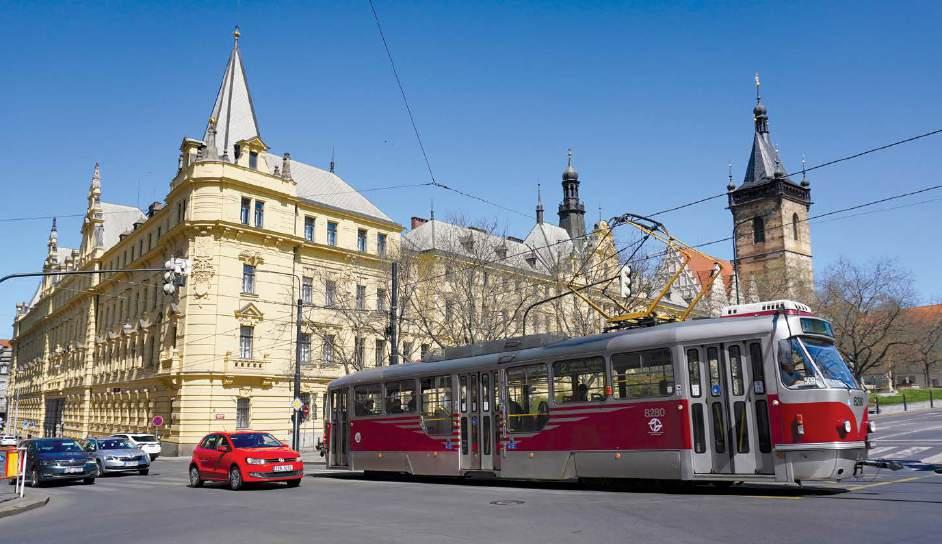

Vinohrady district. From the Muzeum stop a further tram link will also be built to the main railway station and Opletalová Street, where a new tram curve and short stub was put in place in 2022. The opening of these two chords through the heart of the city is foreseen by mid 2027 and will help alleviate congestion along the tram corridor through Jind ř išská Street, which has become an overused bottleneck.
Trams did previously run on the upper section of St. Wenceslas Square in the 20th Century, but operation was discontinued after the opening of the Metro line beneath the square. Eventually the tram tracks were removed in 1982. Plans to return light rail traffic to Václavské náměstí have been in place since
2005, showing just how elaborate and complex the planning has been, as the construction works have also coincided with a general redesign and enhancement of the public spaces in one of the city’s premier areas. In the future, it is planned that the new tram route on the upper section of the square will be used by lines 6, 13 and 21, as well as the night line 95.
Aside from these projects, a number of other schemes are due for development by the early 2030s (these planned tramway extensions are marked as dashed lines on the map).
In 2024, Prague celebrated the 50th anniversary of its underground rapid transit system. The local Metro first opened with the north-south route section of line C from Sokolovská (now Florenc) to Kačerov in May 1974.
ABOVE: Car 8280 is one of those retrofitted T3R.PLF which still sports the silver and maroon livery first introduced for these modified vehicles in 2006. These cars are typically used on line 2, as seen here near Novoměstská radnice.
LEfT: The articulated Tatra type K2 car 7000 is a special addition to prague’s heritage fleet. Suitable for deployment on all nostalgic lines, this stylishly restored vehicle was originally built in 1977 for Bratislava, but only ever ran there as a works vehicle. While the K2 never operated in revenue service in prague, the management of Dpp was keen to acquire one and bring it back to its ‘birthplace’ in order to enhance the otherwise complete collection of post-war Tatra tram types. After a full overhaul in Brno, the classic K2 returned to prague in late 2022 and has been in occasional public use on lines 23, 41 or 42 since early 2023.
Opened: 1875 (electric from 1891)
Lines: 26 daytime, 9 night time
Depots: 8 + 1 museum shed dedicated to heritage operation
Gauge: 1435mm
Power supply: 600V dc
Size: 151km (93.8 miles)
General frequency: 8-10 mins, peak every four mins
Prague Integrated Transit (PID): www.pid.cz
municipal operator: Dopravní podnik hl. m. Prahy (DPP) www.dpp.cz
Civic information: www.praha.eu
Tourist information: www.prague.eu and www.praguecitytourism.cz
Trolleybus operation: First generation network 1936-1972, return of trolleys in 2017. The growing network of lines has numbers all in the 50s range, such as line 59 to the airport.
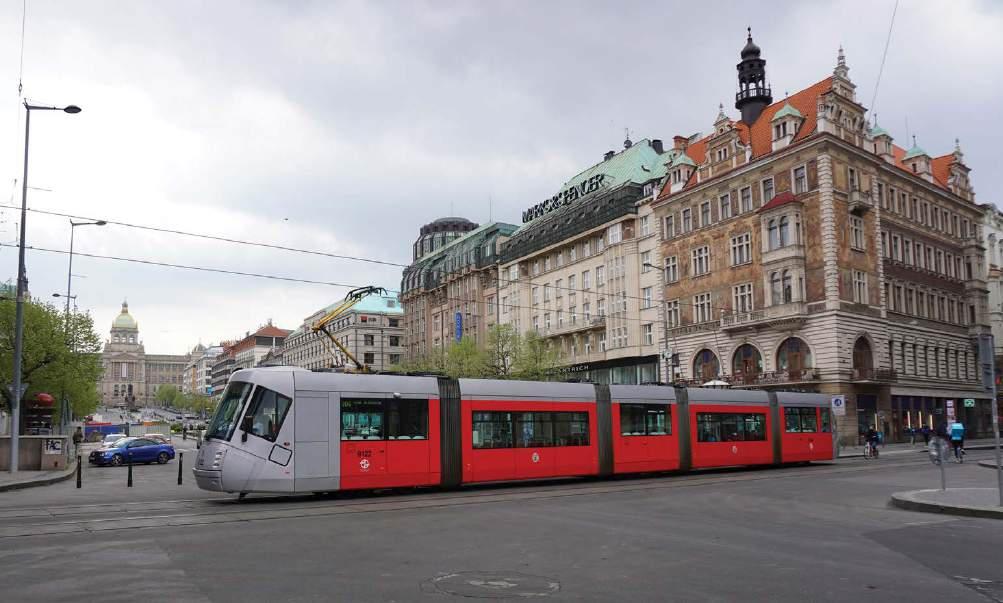
ABOVE: During the first COVID lockdown in April 2020, the sparsely-used Škoda 14T 9122 in its original livery from 2006-09, passes over an empty St. Wenceslas Square. As the main boulevard of the city, this place is normally full of people, yet here is virtually empty. As of September 2024, new points have been fitted to lead to the upper part of the square, which can be seen behind the tram. To the rear is the landmark National Museum, which will also be served by the new city centre tram extension as of 2027. Behind the museum is the existing corridor of lines 11 and 13 through the Vinohrady district. In late february 2025, municipal operator Dpp signed a contract with Škoda’s Ostrava-based subsidiary Ekova to complete the phased mid-life refit of up to 52 of these 14T, which are sometimes also referred to as Elektra.
“In 2022 Pragoimex was awarded a contract... that will ensure that the iconic T3s continue serving well into the 2040s.”
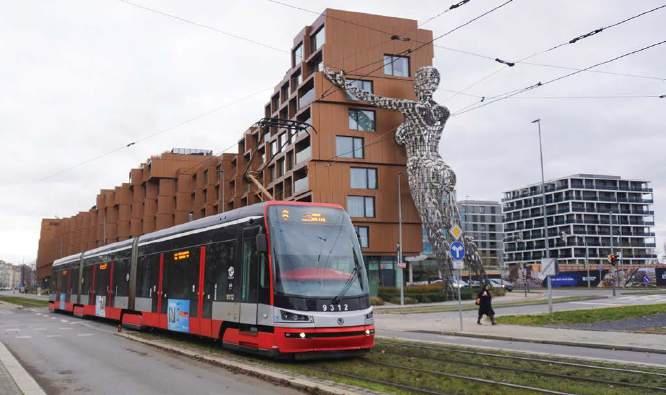
The 125 LRVs
Škoda 15T ForCity Alfa can be recognised by their simpler red, black and grey livery, without yellow stripes. These were delivered from 2009-14 and are numbered 9201-9325. In December 2024, 9312 is seen passing a new residential development before arriving at Invalidovna in the city’s riverside Karlín district.
From August 1978 to April 2015, another 17 extensions were opened in stages, taking the underground network to its current size of 65km (40 miles) with 61 stations and the three lines: A, B and C.
Since spring 2022 the new northsouth Metro line D has been under construction. It is scheduled to undergo phased inauguration from 2029-31. Fully automated, the 10.6km (6.6-mile) line will primarily serve the south of the city and have junctions with the existing Metro C at Pankrác, as well as line A at its northern city centre terminus Náměstí Míru. At Nové Dvory, one of the ten future stations of Metro D, a link to the tramway network will be built by 2027 in the form of a 2km (1.2-mile) extension of tram line 19 from its current, only temporary, endpoint at Libuš. The automated rolling stock of line D will be based at a purposebuilt facility at Depo Písnice, the southern terminus.
The municipal public transport company DPP is currently in the tendering process for 69 fully automated underground trains with the consortium of Siemens/Škoda competing against Alstom and Stadler. In addition to their deployment on line D, these new trains will also be introduced to the busiest line C, allowing full automation and an associated capacity increase of 20%.
On the light rail rolling stock front, the prototype of Prague’s newest
generation LRV was unveiled in January 2025 at Škoda’s company test track in Plze ň. In early 2024, DPP ordered 40 single-ended 52T ForCity Plus trams from Škoda, with contract options for 160 more. Of these 32 m long air-conditioned low-floor cars, 20 will be delivered in 2025, with the second batch of 20 more following in 2026. They will be based at the extensively rebuilt, stateof-the-art Hloub ětín depot in the east of the city, which is now DPP’s most advanced light rail stabling point.
At the same time, DPP is continuing the cost-effective approach of upgrading the iconic Tatra T3 cars with either retrofitted or all-new bodies that include low-floor centre modules engineered by Pragoimex and built by KOS in Krnov. These type T3R.PLF have been in use since 2006 and were initially deployed with a distinctive silver and maroon livery, but recently have been updated with the more traditional light red and cream appearance of the T3 fleet. The newest variants of the T3R.PLF can also be spotted with the modern LED strips placed into the vehicle doors, which are illuminated in either green when it is suitable to board at stops or in red, when the tram is about to depart.
In 2022 Pragoimex was awarded a contract with options for up to 65 more T3R PLF, which will ensure that the iconic and indigenous T3s continue serving their birthplace well into the 2040s. The upgraded Tatras are deployed on routes with lower demand, such as lines 2 and 7, but also appear on the night services, which run seven days a week and are numbered 91 to 99. From Sunday to Thursday the interval from midnight to 4.30 is half-hourly; on Fridays and Saturdays the popular ‘No ční linka’ runs every 20 minutes, with all lines connecting to each other at the city centre interchange Lazarská.
This year marks the 150th anniversary of Prague’s tramway, with the first horse trams being introduced in 1875. The city was a part of the expansive, multi-ethnic Austro-Hungarian empire at that time. In October 1918, a few days before the end of World War One, Czechoslovakia gained independence and Prague became the new capital city, which also sparked a process of urban growth and transport development. Following the peaceful end of the Iron Curtain in the ‘Velvet Revolution’ in November 1989 and the amicable split with Slovakia in the ‘Velvet Divorce’ in January 1993, Prague has further flourished as the administrative and commercial capital of the Czech Republic. As a crucial rail junction in Central Europe and beloved tourist attraction, Prague is as accessible as it is vibrant.
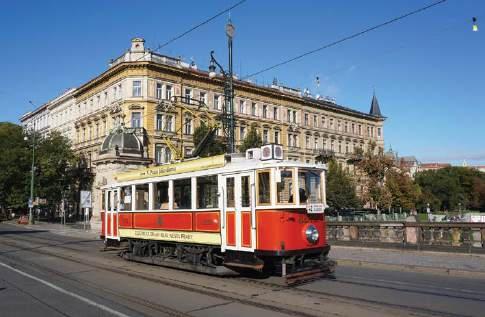
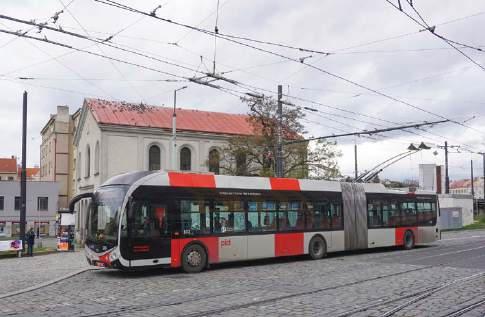
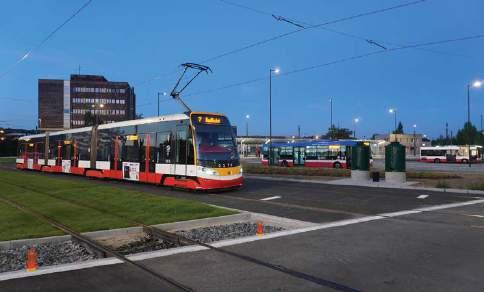
LEfT: Vintage trams are a common sight in prague’s picturesque old town, as they are deployed on heritage sightseeing routes 41 and 42, which use the older Ringhoffer stock from the early 20th Century. These two tourist ‘hop-on, hop-off’ lines require a supplement, while the regular line 23 can be used with a normal ticket. Heritage stock is based at the Vozovna Střešovice transport museum, which is located in relative proximity to prague Castle. Here the double-ended Ringhoffer car 2272 from 1931 is seen passing over the River Vltava on the elegant Most Legií bridge, dating from 1901.
LEfT: The major palmovka transport interchange is where prague’s secondgeneration trolleybus network was launched in 2017, with line 58 services to Letňany using a combination of newly-fitted overhead catenary and powerful traction batteries for off-wire range extension. All trolleybus routes are now numbered in the 50s, including line 59 from the metro junction Veleslavín to the airport. On 20 November 2024, one of the new articulated trolleys provided by the consortium of SOR and Cegelec is seen in front of the old synagogue at palmovka.
LEfT: At dawn on 3 September 2022, the single-ended second series Škoda ForCity Alfa 9376 is seen at the new Depo Hostivař tram stop, shortly after this 1.25km (0.77-mile) extension and link to the Metro line A terminus was launched in August. At the time, it was the third tram extension to open in 2022.
Local travel: Seniors over 65 benefit from free public transport on the urban lines operated by DPP. An official photo i D as proof of age is considered the ticket equivalent. At all major points of arrival, such as the airport or the main line railway stations, there are either staffed DPP sales offices or user-friendly ticket vending machines. Printed public transport maps are still available but can be hard to find, so it is worth using urbanrail.net on any electronic device to see both the tram and metro network maps. For visitors under 65, 24 or 72-hour tickets represent the best value. These cost cz K120 ( eur4.78) or cz K330 ( eur 13.15) respectively.
What is there to see and do? As one of the most popular visitor destinations in central europe, Prague needs no introduction and offers something for every taste and budget. r ich in culture, architecture and art, the city’s principal attractions are comfortably reached on foot or by public transport. The fast and frequent tram services benefit from multiple lines duplicating each other in the city centre and even outlying neighbourhoods. l ine 22 and 23 are ideal to get an initial overview, with the Vinohrady, Vršovice, letna, bubeneč and Dejvice districts being the most popular with locals for going out. i ncidentally these are also where expats typically choose to live in the city, and thus feature a vibrant way of local life beyond the beaten tourist path. The tram lines through these districts also offer excellent scenery and rich historic architecture from the late 19th and early 20th centuries.
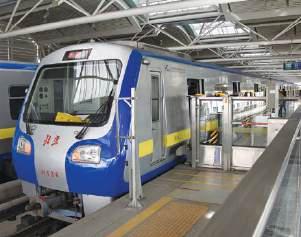
China is continuing with its vast expansion of metros across the country.
Hans-Ulrich Riedel provides an overview of those planned for 2024.
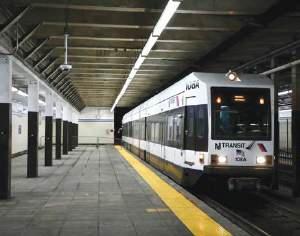
Andrew Grahl provides an update on the plans underway in the Big Apple that will help to keep the 20 million New York Metropolitan area residents on the move.
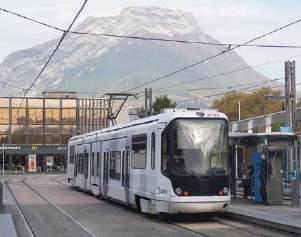
Tram line D has recently been extended to the main railway station. Andrew Thompson reports on this and other developments from the Alpine city.
+ Dubai metro and tram update
+ A funeral in Berlin: Woltersdorf bids farewell to its Gotha cars
+ The latest news and analysis, system and technical development


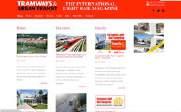
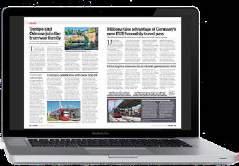

TAUT speaks to UITP’s secretary g eneral mohamed mezghani about what to expect at the 2025 summit in hamburg, and about his vision for the future.
Mohamed, the UITP Summit is fast approaching, and Hamburg will be the first host city under the new annual format. How is the team preparing for the 2025 gathering (15-18 June)?
In some ways it’s hard to believe that we’re on the cusp of hosting the next UITP Summit, when the 2023 edition in Barcelona feels so close to mind. There’s always a special energy in the air when the event is approaching. We’re heading into a new era of the UITP Summit, with an annual format beginning in 2026 with Dubai set as the host city (the UITP Summit will be hosted once a year with the new format). The excitement is growing. It’s not an easy task to arrange an event such as this (in a past life I have been project manager of the UITP World Congress, so I know this first hand!), but it’s important for our members, partners and stakeholders that we do this. We say that ‘the public transport sector meets here’ for a reason. It’s the place to be, and the standout moment in the calendars of all urban mobility professionals.
Our delegates, of course, don’t just get to attend the UITP Summit for the world-class exhibition and sector-leading programme, they have an entire agenda created for them. At the heart of that is people. We’re a member-led association, and our sector is a people-driven one. Our delegates get the opportunity to network, interact, and experience. I would say that collaboration is a theme running throughout the Summit.
it comes to the Summit, you need to go beyond the existing relationships and expand your community. Last Autumn we held a Summit launch in Hamburg with the explicit reason of meeting and interacting with the local and national players. They play a key role as major stakeholders and supporters of Hamburg’s success as a Summit host city.
With politicians, CEOs, national press, and industry leaders gathering together, the Summit has a chance to shine under a different kind of spotlight – one that shows how important bringing the Summit to your city is for the local and national economy. And there’s really no better way to get the local and national audience engaged and interested than personalising the Summit for them with this special introduction. It was a huge success and only confirmed that Hamburg is a city on the cutting edge of innovation, mobility expansion, and an active arena for public transport that others can aspire to.
UITP

“Think of the public transport sector as one big community, one with collective goals, aims and missions.”
But you are not just attending the Summit, you also have the opportunity to discover our host city. In Hamburg, you will be welcomed to a city with a rich culture that offers seamless connections for its residents and visitors. With a public transport network to be proud of – and ambitious mobility plans in place –Hamburg is an ideal setting to welcome the UITP Summit. At UITP, we have just launched our brand-new Strategic Plan, centred around putting people first. Those people are our colleagues, our members, and the policy makers, with a focus on delivering for the public transport sector. The Summit is about bringing the sector together and collaborating to drive excellence in the sector. I’m very much looking forward to it.
Has UITP been interacting with the local players and audience? What has that experience been like?
The UITP Summit is the largest event of its kind focused on advancing urban mobility, and is global on every level. But what is extra special about the Summit, is that it also has a local feel. The local hosts and the local players are a large part of the experience.
It’s important to build a special relationship with the audience, especially now that we will go back to Hamburg for a further confirmed edition in 2027. We have many members in Germany, and our connections there are strong. But when
What can you share with us about the programme at this stage? Do you have any news to share on the topics?
Our programme is coming together at an impressive speed, and the UITP Summit Programme Committee is working hard to deliver it. For now, our programme overview is available, as are the six session tracks that will define the focus of the entire programme. The six tracks are Net Zero Cities, Operations, Lifestyle, PeopleCentricity, Sustainability and Technology. This means that the full programme will be guided by these tracks, and when expanded they will focus on driving policies to net zero, operating according to local needs, sustainable mobility as a lifestyle, focus on people and communities, aligning mobility planning with the SDGs, and technologies for change. What you can see from this approach is that the most pressing sector topics will be brought to the table for exchange with our delegates.
The Summit programme will be notable in that it will discuss topics in the context of recent political developments and changes. Climate action, services, urban living, passenger and employee wellbeing, diversity and inclusion, sustainability targets, and technological innovations... these will be the guiding direction, and people will remain as the red thread throughout it.
With the new annual format in place, the 2026 edition is already in the agenda. From Hamburg you head to Dubai –can you give our readers a sneak peek?
The UITP Summit is always closed off with a handover to our next host city. This time of course the handover will be one that will come within the next year of wrapping up Hamburg! Under our new format we head outside Europe for the next edition, and that means from 21-23 April 2026 we will be focused on ‘Destination Dubai’. UITP and Dubai have a very lengthy and successful relationship that goes back many decades.
Our membership started to grow in the UAE in the early 2000s, and to build strong relationships we have had an office there since the mid-2000s. Dubai is a city that grows at a very impressive rate, and with that development, urban mobility is always at the heart of it. In fact, when the Summit arrives in Dubai in 2026, it will be exactly 15 years since the Summit was last hosted there in 2011.
Can you imagine what developments will have taken place in a location such as Dubai after 15 years? Public transport has developed at a truly impressive rate thanks to the strong focus and commitment of our local host Roads and Transport Authority Dubai. Of course we do not just land in a location by chance. Dubai as the local host city is also an acknowledgment of the impressive public transport developments in the MENA region, including (but not limited to) Egypt, Morocco, Qatar, Saudi Arabia, and more. The MENA region is alive with innovation, and the Summit in Dubai is sure to be an impressive gathering.
It is of course too early to discuss the programme, but the conversations that will take place in Hamburg will guide us to what talking points will be on the table for the Dubai edition, so the Summit becomes even more important when held on an annual basis. By attending the Summit in Hamburg, you can contribute to reviewing the trends and discussing the direction the sector should take.
Dubai will have the distinction of being the first nonEuropean location to welcome the Summit under our new format, and in 2026 it will actually be 140 years since the first UITP Summit (under a different name) was held in 1886. It really will become ‘Destination Dubai’!
You mentioned that the first Summit was hosted in 1886… From its original name and premise to the new annual approach in 2025: What does the Summit mean to you as a public transport professional?
The short answer would be that it means a great deal. My own history with UITP is lengthy, and I can think back
to many World Congresses, Global Summits and recall the people I met, and the conversations we focused on.
When I think of what public transport was then and is now – this is a sector that creates and innovates. Change does not come overnight, and if we are determined to make lasting progress in public transport then we need collective thinking for workable solutions. It’s a challenge, but if we look at what the entire sector was able to achieve during the global pandemic, we know that public transport steps up to face its challenges. Looking at the impacts of climate and extreme weather, tackling the latest technological innovations, recruiting, and retaining staff… public transport is a vital entity for our cities, one that is facing important challenges. I think that in itself shows how important the Summit is. And now that the Summit is annual, I hope the achievements made, and the memories built, will be more special.
When it comes to making memories, there are plenty of opportunities to do so. The most recent edition in Barcelona in 2023 was home to over 10 000 participants, 425 speakers, 335 exhibitors, 250 journalists, all from over 110 countries. That’s a lot of people to interact with!
And on a personal level, what the Summit means to me is that brilliant people aspect. Public transport is about people, and when you have thousands of them gathered together determined to change our sector, our cities, and our planet for the better, what more could you want? If you think of the public transport sector as one big community, one with collective goals, aims and missions – in that instance, bringing the entire sector together makes the UITP Summit somewhat of a family reunion. And this family has a joint objective: To improve the quality of life in our cities, and move people for a sustainable and inclusive world. For the Summit, the delegates come from across the globe, and from the entire mobility ecosystem. This is what makes the UITP Summit the place to be!
www.uitpsummit.org/hamburg2025/
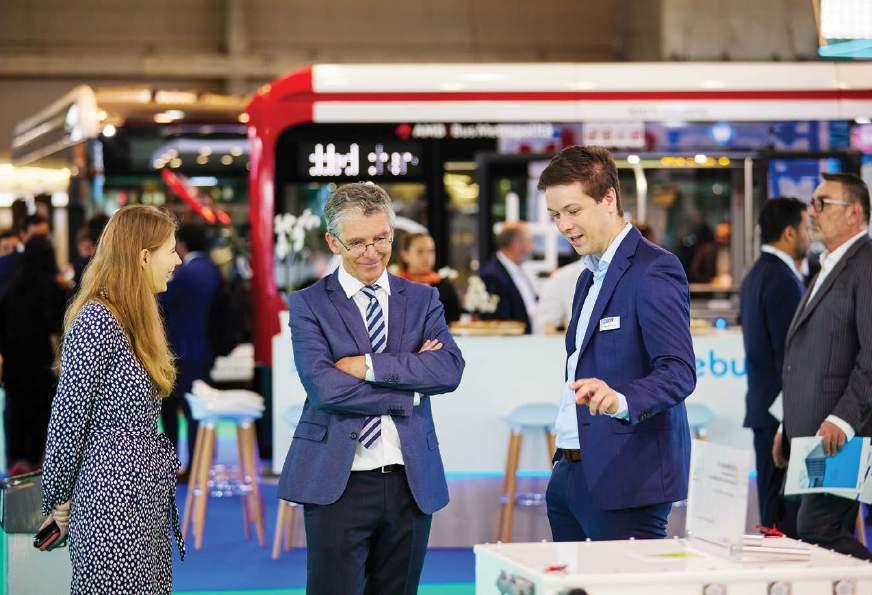
BUENOS AIRES. Tenders are being invited for the first 5km (3.1 miles) of metro line F, from Tucamán to Brandsen. Due to open in 2031, the line will require 14 new trains. RGI
GRAZ. The new inner-city bypass tramline is due to open on 25 November. A total of EUR228.7m is to be invested in modernising Steyrergasse depot, including a new building for 25 trams.
BS WIEN (Vienna). E2 trams 4026/43/5, 4305 and trailers 1423/45/68 have been withdrawn. Fire-damaged U-Bahn set 2282+3382 has been scrapped.
The World Tram Driver Championship is due to be held on 13 September.
BS WIEN – BADEN (WLB). Alstom Flexity 531/532, the first of a new batch of 12, entered service in March. tramwayforum.at
MINSK. Trams on lines 3, 4 and 5 will not serve D/S Ozero stop from 15 March to 1 May due to metro construction work.
An order has been placed with TMH Metrovagonmash for four five-car metro trains, with delivery this year. transphoto.org
BELGIUM
ANTWERPEN (Antwerp). A six-month project to build a new tram crossing between Melkmarkt and line 7 was to start on 31 March. Line 7 is cut back to Groenplaats. BS BRUXELLES (Brussels). Line 35 (Esplanade – Bienfaiteurs), introduced last year, was reduced to Esplanade-Schaerbeek Gare from 10 March due to low patronage. Road works mean there is a temporary terminus at Docks Bruxsel.
Articulated PCCs 7760/99 and 7818/21 have been scrapped. T-2000
RIO DE JANEIRO . Plans for the 22km (14-mile) metro line 3 to Niterói have been revived. A tender for construction is to be issued this year. IRJ SÃO PAULO. A limited shuttle service on the 1.8km (1.1-mile) southern extension of commuter rail line 9 started in early March. RGI
MONTRÉAL Québec’s provincial government has approved the 38km (24-mile) Montréal Est
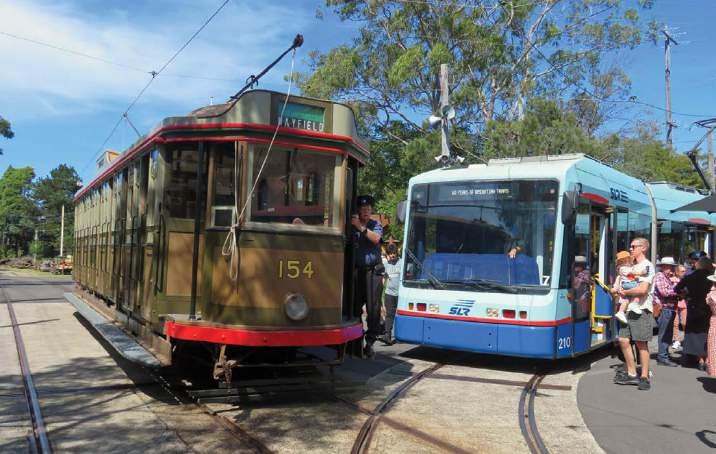
tramway project. Work on the CAD18.6bn (EUR12bn) project should start in 2027. D. Drum TORONTO. Work has started at Hillcrest workshops to create space for a new 25-tram depot. The arrival of 60 new trams necessitated the expansion.
HONG KONG. MTR introduced a 75-minute Tuen Mun Voyager sightseeing tram tour on 22 February. It follows a circular route through Tuen Mun and can be used by passengers holding the HKD50 (EUR6) Light Rail Travel Pass. Tram 1140 has received a dedicated livery and travel ambassadors on board provide commentary and sell souvenirs.
RGI
ZAGREB. The first new KONČAR low-floor tram, 2401, entered service on line 1 on 10 March.
L. Lukacic
OSTRAVA. A tender for up to 25 32.4m trams with rotating bogies is being prepared. It requires 16 to be delivered within 32 months of signing. The new trams are to replace Tatra KT8D5 cars.
cs-dopravak
PLZE Ň . The last Tatra T3R high-floor trams (257/60) were withdrawn on 18 February.
cs-dopravak PRAHA (Prague). A parade of trams on 21 September is to celebrate 150 years of public transport in the city. Tatra T3 7188 and Škoda 15T 9201
have been given special liveries advertising the event.
The 30th T3R.PLF from KOS at Krnov to arrive was 8768, officially a rebuild of T3 8226. This was followed by 8769 (ex-8312).
A CZK134m (EUR5.4m) contract has been signed with Metrostav to reconstruct the Pet ř ín Funicular and provide new cars. It should re-open in 2026. dopravacek.eu, RGI
HELSINKI. ForCity Smart Artic X54 630 became the first of 23 such Škoda Transtech trams to be delivered to the operator. Costing EUR3.7m each, the double-ended, five-section trams are destined for the Crown Bridges line. This is to open in 2027; they will run on line 13 in the meantime. cs-dopravak
ANNEMASSE. The first rails were welded for the 1.1km (0.7mile) Geneva line 17 extension on 21 February. The EUR63m project to take the tramway through the pedestrianised area to Perrier-Aubrac is to be completed in 2026. tram-p.fr
BESANÇON. A new terminus at Beûlard is expected to be built during 2026. lineoz.net
BORDEAUX . New tram services will be introduced in September: Floirac Dravemont – Gare de Blanquefort (E) and Gare de Begles – Aéroport Mérignac (F). This change will require new pointwork to be installed. BS LE HAVRE. A framework agreement has been signed with
Alstom for eight 33m Citadis trams. They will be used on the new 14km (nine-mile) line C from December 2027. lineoz.net LE MANS. No trams will operate 15 July-15 August, to permit platform lengthening. BS MONTPELLIER. The first of 60 new CAF trams was delivered from the Bagnères-de-Bigorre factory in France on 7 March. They should arrive at the rate of two per month and are to be used on the new line 5 from December as well as replacing some original stock. lineoz.net
NANTES. Line 1’s extension to Babinière is due to be opened on 19 May; a new depot is to follow on 25 August. T-2000 PARIS. T2 has been cut back from Porte de Versailles to Court Suzanne Lenglen for ten months to permit a new track layout to be installed at the old terminus.
On 23 March, Keolis/SNCF subsidiary Stretto became responsible for the 10km (sixmile) Esbly – Crécy-la-Chapelle tram-train service, now T14. STRASBOURG. An option has been exercised in the contract with Alstom for an additional 27 45m Citadis . To be delivered in 2026-27, they will bring the total to 39. lineoz.net
TOURS. CAF is to supply 19 42m Urbos 3 trams for the future 12.5km (7.8-mile) line 2 (La Riche – Chambray-lès-Tours) in late 2027. They will feature onboard energy storage for the 2km (1.2-mile) Gare SNCF – Place Choiseul section that lacks overhead. They are to be built at CAF’s Bagnères-deBigorre plant. RGI
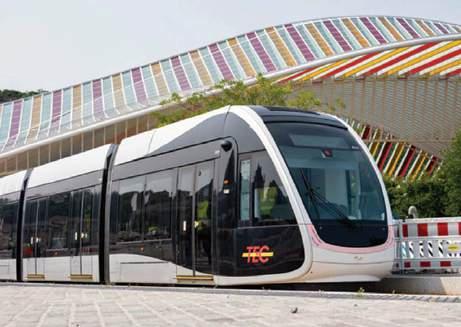
BERLIN. Alstom delivered 5002, the second 50m Urbanliner, on 6 March.
Initial trial runs on the S21 Stadtbahn link from Hbf to Gesundbrunnen took place on 26 February, using historic S-Bahn sets. Passenger service should start this summer.
BRAUNSCHWEIG. The Land has promised EUR24m towards the purchase of 12 new trams in 2028-29, as well as EUR5m for infrastructure improvements. BS BREMEN. Bürgermeister-SmidtBrücke reopened to pedestrians, bicycles and cars on 1 March. Further work is required before trams can use it again and diversions remain in place. BS CHEMNITZ. Steam locomotive 98.7056, built in 1886, was positioned on the tramway between Zentralhaltestelle and Roter Turm as 80 000 visitors came to the city on 18 January to witness the start of it being the 2025 European City of Culture. Trams were diverted.
Tatra T3D 513+514 is now displayed at the Subbotnik cultural centre in Bernsdorf. BS DÜSSELDORF. Cars 4304/58/59 became the last HF6 Stadtbahn vehicles delivered by Alstom.
Continuing delays mean U81 to Flughafen is unlikely to open this year. BS FRANKFURT/Main. Alstom T-class trams remained out of service in early March, so Pt high-floor cars 138/48, 736/49 were used on lines 15 and 17. BS GOTHA. The four trams ordered from Stadler are Tramlink , not TINA as reported in TAUT 1047. There is an option for a further six. BS HANNOVER. A cost-benefit analysis has been commissioned for the Stadtbahn extension from Garbsen to Garbsen-Mitte.
The vehicle order with CAF is to be increased to 59 cars.
Stadtbahn car 6001 of 1974 has been repainted light green to mark 50 years of the system. BS HEIDELBERG. MGT6D trams 3261/62/65/68-69/71 have been sold to Schöneiche’s tramway. BS JENA. Delivery of Stadler Tramlinks had reached tram 854 by early March. At that time, the only remaining 1996-97 cars were 610-12/16; the others having been sent to Łód ź (Poland). BS KARLSRUHE. Three people were killed on 11 March after a tanker lorry hit AVG 821 on a level crossing and caught fire. Lines S31 and S32 were closed between Zeutern and Odenheim for several days thereafter. DS KIEL. Final authorisation for the proposed new EUR441m tramway took place on 13 March. An application for federal funding is to be submitted this summer. BS MAGDEBURG. Alstom Flexity 1401 and 1402 had arrived by the end of February. Testing beyond depot limits began in March. Tatra T6/B6 set 1280+2144 has joined the museum fleet.
MANNHEIM. The Škoda fleet in late March comprised: 36T 1401-09; 37T 1801/02-1873/74; 38T 1501/02. Trams 1410-65 and 1503/04-1523/24 are still to be delivered. Ex-OEG trams 4117-22 of 1996 are to be withdrawn. POTSDAM. The first of 13 Stadler Tramlink 42m low-floor trams (441) arrived on 13 March. The contract cost for each tram is EUR4.76m. Delivery from Valencia involves shipment from Santander to Zeebrugge. transphoto.org RHEIN-RUHR. VRR has launched Project Calo that aims to introduce a cash- and paper-free payment system by early 2027. BS RUHRBAHN. Bus replacement on lines 103, 105 and 109 is in force between Rathaus Essen/ Hbf and Helenenstrasse/ Frohnhausen until at least 1 June to permit work on the Citybahn to take place.
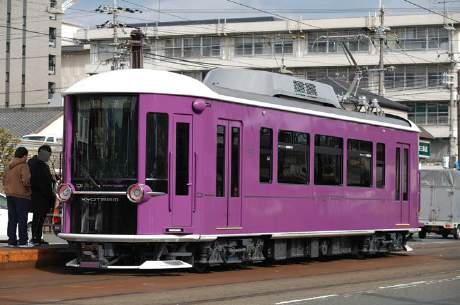
Lines 101 and 106 are suspended between Helenenstrasse and Germaniaplatz due to a legal challenge by residents unhappy with Citybahn infrastructure work.
BS
KOLKATA (Calcutta). Up to eight trams were running on lines 5 and 25 in mid-March. Local correspondents predicted that line 24/29 would re-open at the end of March. B. Kussmagk
DUBLIN. Fine Gael’s Teachta Dála for Dublin Bay South, James Geoghegan, has said that an extension to the Luas Red Line must be approved before the Poolbeg West development is completed. The extension would connect Ringsend and Irishtown via a bridge across the Liffey.
Police have launched an investigation after rocks were placed on Luas tracks in the Ballymount area on 6 March.
MANX ELECTRIC RAILWAY. The 132nd year of operation got underway on 18 March. Cars 5, 7 and 21 – plus trailer car 59 – were in use while car 19 underwent tests prior to its planned return to service later in the season.
CATANIA. A EUR124m contract has been signed for the extension of the metro from Monte Po to Misterbianco Centro. skyscrapercity ROMA (Rome). Construction of the first phase of an 8km (five-mile) orbital tram line started near Ponte Mammolo on 4 March. Completion is expected in July 2026. RGI
HIROSHIMA. Two new Kinki Sharyo Green Mover Apex trams –
5210 and 5211 – entered service in March. BS
ASTANA. The new 22.4km (14-mile) automated light metro is due to be completed by the end of 2025. It will be worked by 19 fourcar trains from CRRC Tangshan. Railway Supply
AMSTERDAM. Jan Evertsenstraat is closed between Admiraal de Ruijterweg and Mercatorplein 31 March-6 July. Lines 7 and 13 are diverted. OR DEN HAAG (The Hague). Work to lay tracks for line 9 past Delft Technical University has involved measures to eliminate electrical interference. Rails are encased in rubber with extra concrete and protected conduits. OR ROTTERDAM. Work to rebuild Hofplein is to start on 14 April and last until 2026. Road traffic is being diverted and the track layout simplified.
The regional authority is progressing plans for an extension to Nieuw Kralingen that could be completed in 2030.
EUR120m is being invested in extending and modernising Waalhaven metro depot by 2031. A new metro station is planned. OR
OSLO. A pair of works trams have been ordered from Windhoff for delivery in 2027. BS
PANAMA CITY. An agreement has been signed with the Japan International Development Agency for a JPY159.5bn (EUR983m) loan to build phase three of the 25km (16-mile) line 3 monorail. RGI
KATOWICE. Tramwaje Konurbacji Ślą skiej is to carry out
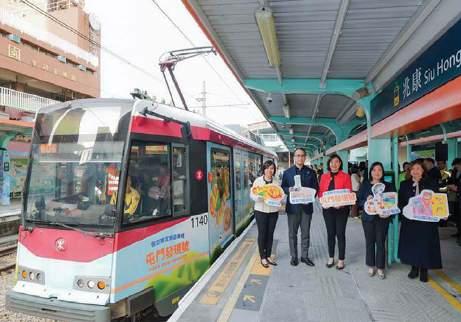
a feasibility study for the return of trams to Gliwice. Trams last ran there in 2009 and 95% of tracks have been removed. TP KRAKÓW. A further five doubleended Duewag GT8SU trams have arrived from Düsseldorf (3202/17/20/29/35).
Grunwaldzki bridge will be closed for six months from 10 May, leaving a tramway stub terminus at Plac Grunwaldzki. A 6km (3.7-mile) metro is to be built in 2028-33 linking Stadion Miejski and Olsza via Kraków Główny railway station. This is the first part of what is intended to become a 26km (16-mile) line. BS POZNA Ń . Modertrans Gamma cars have begun entering service. The first was 941 on 24 March. TP
LISBOA (Lisbon). A further EUR150m in funding for the 11.5km (7.1-mile) Violet Line project has been approved by government after a 28% increase in construction costs. Completion is expected in 2029. IRJ
GALAȚ I. The first two of ten new 18m Astra Autentic trams entered service in early March. The contract value for this batch is RON80m (EUR16m). DS ORADEA. A tender is to be issued for 13 tram-trains. This will allow integration of suburban rail with the tramway to form a 32km (20-mile) network.
A further nine 27m Astra Imperio trams (321-329) were to be delivered from May. TR
RUSSIA
KALININGRAD. Corsair trams returned to line 5 in March.
J. Carpenter KRASNODAR. Zapadnoye depot turned out the first T811 Sinara coupled tram set on 19 February. Belkommunmash is to deliver 20 (620-639). transphoto.org
ROSTOV-NA-DONU. A trial rebuilding of seven PKTS 71-911 CityStar trams from 2016-17, with new front and rear ends, has been undertaken by Sinara. This is part of the concession agreement for the network modernisation. transphoto.org
SAMARA. The first of 12 71-911EM Lvyonok bogie trams (500-511) entered service on 21 February. transphoto.org ULYANOVSK. Tram traffic over the Minaevskybridge was temporarily re-routed from 9 March. This affected lines 9, 10 and 22. transphoto.org YAROSLAVL. Concession holder Movista has taken delivery of eight Ust-Katav 71-628 bogie trams (201-208). transphoto.org
SERBIA
BEOGRAD (Belgrade). Street protests against the government led to the cancellation of all public transport services on 15 March. transphoto.org
SLOVAKIA
BRATISLAVA. A framework contract for up to 60 49m doubleended trams has been placed with Škoda. If all the ForCity Smart vehicles are delivered, the contract will be worth EUR397m. TP
BUSAN. Rising costs have put the 5.2km (3.2-mile) environmentallyfriendly Oryokdo Line tramway in doubt. A feasibility reassessment report is imminent. Costs have risen from KPW47bn (EUR48.5bn) to KPW91bn (EUR94bn). The line was due to open in 2023. It could be incorporated into Busan’s urban rail network. H. Usui
SPAIN
MADRID. Test running on the 2.6km (1.6-mile) metro line 3 extension started on 20 March. The Villaverde Alto – El Casar line is expected to open in April.
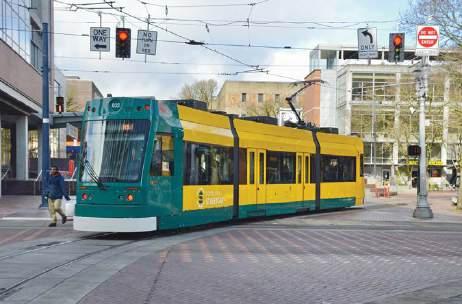
Construction has started on the 17km (11-mile) extension of metro line 5 from Alameda de Osoria to Barajas Airport. Opening is planned for the second half of 2028. IRJ
TPC. A CHF140m (EUR147m) contract has been awarded to Stadler to supply 13 Beh4/8 threesection rack EMUs by 2028. They will be used on the Aigle – Leysin and Bex – Bretaye lines. RGI BASEL. Buses are to replace Baselland Transport tram services from Barfüsserplatz to Gare de St-Louis until 6 July to permit work in Burgfeldstrasse.
Line 19, the former Waldenburgerbahn, carried 2.3m passengers in 2024. Before it was re-gauged from 750mm to 1000mm gauge in 2022, that figure was 1.9m. EA ZÜRICH. Tram 2000 2095 has been rebuilt with seats for 48 passengers who can sample culinary offerings during a city tour.
TAIPEI. Taipei city government has taken over construction of the second phase of the Green Line light metro, which is 35% complete. Of the 13.3km (8.3-mile) Wanda – Shulin line, 2.8km (1.7 miles) is in a subway while 3.9km (2.4 miles) is elevated. IRJ
BANGKOK. The 2.7km (1.7-mile) Pink Line monorail extension from Muang Thong Thani to Muang Thong Thani Lake is due to open on 19 July. urbanrail.net
KYIV. A tender has been issued for ten five-car metro trains, financed by a loan from the European Bank for Reconstruction & Development. TP
LVIV. The first two Swiss Vevey Be4/8 trams in service were 1240/1 (ex-Bern 736/742). They took to line 1 on 5 March. transphoto.org
UNITED ARAB EMIRATES DUBAI. The Roads & Transport Authority has issued a Request for Proposals for the construction of the planned 30km (19-mile) Blue Line metro linking Al Ghubaiba and Dubailand via Business Bay. It is hoped that work can be complete in 2029. The new line will require 28 automated trains. meed.com
UNITED KINGDOM
GREATER MANCHESTER. No tram services are to run between Market Street and High Street/ Church Street 25 March-23 April, to permit track renewal. Trafford Centre services will run to Etihad Campus and Altrincham services will run to Bury, while other cross-city services will divert via Exchange Square. Replacement buses are to operate.
A passenger who travelled from Navigation Road to Cornbrook on 19 March made the 50 millionth tap-and-go journey on Metrolink since the payment option launched in 2019. This milestone was passed days before tap-and-go was rolled out across Manchester’s bus network on 23 March.
Transport for Greater Manchester is assisting Greater Manchester Police in investigating reports that a gas – possibly butane – was released inside trams on 20 March and again on 22 March. Eye-witnesses reported a man wearing a gas mask fiddling with a device before they felt unwell. GLASGOW. At least two redundant Subway cars have found new homes. One has moved to Finnieston, where it is to be used as small business units. Another, 107, has been bought by social media star Francis Bourgeois, who has not yet revealed where it will be based.
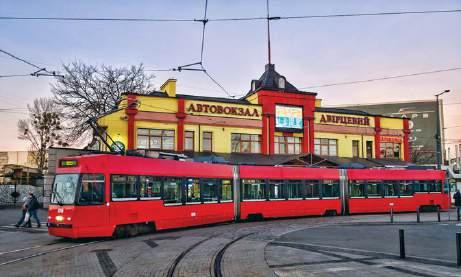
LONDON (DOCKLANDS). A feasibility study into building Thames Wharf station, between Canning Town and West Silvertown, is to be finalised in the coming weeks. It was first proposed over 20 years ago.
LONDON (GENERAL).
Transport for London is to celebrate its 25th anniversary by holding a competition for children to describe their favourite part of the network. Winners will be invited on exclusive tours as well as being able to record public announcements.
Contactless payment systems went live at a further 47 Network Rail stations in February. TfL is working with the Department for Transport and the Rail Delivery Group to add a further 49 stations around the southeast of the UK during 2025.
LONDON (UNDERGROUND).
The leaders of Brent, Lewisham, Southwark and Westminster councils renewed calls for funding the Bakerloo Line upgrade on 20 March.
More than 400 student units and 44 affordable homes look set to be built over Southwark Underground station after the joint venture behind the plans –made up of Transport for London’s property company Places for London and developer Helical –received the resolution to grant planning approval from the London Borough of Southwark.
NOTTINGHAM. East Midlands Combined County Authority has approved a GBP300 000 (EUR360 000) study into possible network expansion options. These could include Gedling, to the northeast of the city, the housing development at Fairham Pastures near Clifton (to the south), and the potential redevelopment of Chetwynd Barracks in Chilwell (southwest).
SHEFFIELD. Supertram stopped accepting on-board credit card payments for CityWide 7 Day and SYConnect 7 Day tickets from 23 March.
TYNE & WEAR. Tyne & Wear
Metro operator Nexus has proposed a ban on vaping and e-cigarette use on trains and at stations. A 28-day consultation concluded on 24 March.
Redundant Metrocar 4001 is to go to the Stephenson Steam Railway for display, while another could be destined for Beamish Museum. Tyne & Wear Fire & Rescue is also set to receive a Metrocar for use as a training aid.
Class 555 555003 has entered service.
WEST MIDLANDS. Ticket machines went live across the system’s 33 tram stops on 26 February; tickets are no longer available from conductors, who will become more akin to ticket inspectors.
USA
ATLANTA, GA. Metropolitan
Atlanta Rapid Transit Authority has selected engineering firm HDR to complete final design work for the 3.2km (two-mile) Streetcar east extension, which it is hoped to open in 2028.
MARTA has also launched a six-month planning study for the 35.2km (22-mile) Belt Line loop that will connect with the extension.
MARTA
CHICAGO, IL. Faced with a USD770m (USD715m) budget shortfall in the next fiscal year, Chicago Transit Authority has outlined plans for a possible 40% reduction in service on rapid transit and Metra commuter rail.
J. May
CLEVELAND, OH. Greater Cleveland Regional Transit Authority has exercised its option to order another 18 Siemens S200 high-floor LRVs, building on the 2023 order for 24 and the 2024 order for six. Delivery of the additional cars is expected in 2026. Mass Transit DALLAS, TX. Suburban members of the Dallas Area Rapid Transit district have introduced bills in the Texas legislature aimed at reducing funding
by up to 50%. If successful, this could mean that the nearlycomplete Silver Line would not open since its operating subsidy requirement could not be met. keranews.org DENVER, CO. Patronage on Regional Transportation District light rail fell from 12.7m in 2023 to 11.16m in 2024. Disruption caused by speed restrictions due to track condition has been blamed.
Corporation Tramways 78 to the National Tramway Museum. They are expected to be returned to running order at Crich.
BLACKPOOL (UK). Tramtown heritage tram workshop tours were to resume on 18 April, with pre-booked tours set to run every Monday and Saturday. Pre-booked guided workshop tours are also to take place on Tramtown open days.
J. May
LOS ANGELES, CA. Los Angeles Metropolitan Transit Authority has selected AECOM to design the planned 10.7km (6.7-mile) East San Fernando Valley light rail project. Mass Transit PHILADELPHIA, PA. The renovated Franklin Square station was reopened on 3 April, 46 years after it closed. W. Vigrass PITTSBURGH, PA. Regional Transit is proposing to cut light rail, bus and incline service by 35% from February 2026, and raise fares with a USD3 (EUR2.78) base fare. This is to meet a predicted USD100m (EUR93m) deficit. The Silver Line light rail system could be withdrawn.
J. May PORTLAND, OR. Almost two years after delivery of the first car, the Brookville Liberty NXT trams began to enter service on the Portland Streetcar system on 12 March. S. J. Morgan ST LOUIS, MO. A trio of exMelbourne W2 trams have moved to ‘heritage tram’ manufacturer Gomaco’s Iowa headquarters after being deemed surplus to requirements on the Loop Trolley. All three were shipped to Seattle from Australia in 1978. Loop Trolley 003 (which was extensively rebuilt) never entered service, while Melbourne 482 and 518 were in store.
Operation of the Loop Trolley has been taken over by Bi-State Develpment, whose operations include the Metro & airport. Funding has been extended from June 2025 until 2028. S. J. Morgan
MUSEUM NEWS
BEAMISH (UK). Track relaying has taken place on the tramway. Once testing is complete, the road will be resurfaced.
BIRKENHEAD (UK). Wirral Council has reduced its financial contribution to the Wirral Transport Museum from GBP4.5m (EUR5.4m) to GBP1.5m (EUR1.8m). Museum owner Big Heritage still plans to re-open the museum in early 2026.
The Merseyside Tramway Preservation Society has gifted Liverpool Corporation Tramways 762, Birkenhead Corporation Tramways 20 and Wallasey
BRUXELLES (BE). Line 39’s centenary will be celebrated on 15 June, with as many museum trams as feasible in passenger service from Woluwe-SaintLambert depot. BS
CHARLEROI (BE). Twoaxle Société des Transports Intercommunaux de Charleroi trailer 44 has returned to its home city after 44 years in France. It is to be restored. T-2000
GREATER MANCHESTER (UK). Manchester Transport Museum Society is to restore Manchester Corporation 173 to working order. Built by Brush in 1901, it was withdrawn in 1931 but was discovered in the 1970s and cosmetically restored using a donor underframe.
KRAKOW (PL). Operation of a three-car N set on line 8 on 16 March marked 124 years of electric tram operation. This was made possible by the restoration of 1952 Konstal trailer 512. The set comprised 304+502+512. TP LOFTUS (AU). The Vintage Tramway Festival on 23 February attracted 1500 visitors. It marked 75 years since the first Sydney tram ( L/P 154 of 1900) was acquired for preservation, and 60 years of tramway operation at Loftus, in the Sydney suburbs. G. Sutherland SPIEKEROOG (DE). Work has started to extend the museum horse tramline to Westend, on the alignment of the former 1885 island railway. spiekeroog.de
Worldwide items for inclusion should be sent to Michael Taplin at Flat 8, Roxan Villa, 33 Landguard Manor Rd, Shanklin, Isle of Wight PO37 7HZ, UK. Please fax: +44 (0)1983 862810 or e-mail miketap@mainspring.co.uk UK and Ireland items, please e-mail uknews@lrta.org
Acknowledgements are due to Blickpunkt Straßenbahn (BS), cs-dopravak, dopravacek.eu, Drehscheibe (DS), International Railway Journal (IRJ), keranews.org, Lineoz.net, Mass Transit, meed.com, Op de Rails (OR), Railway Gazette International (RGI), Railway Supply, skyscrapercity, spiekeroog.de, Today’s Railways (TR), tramwayforum.at, tram-p.fr, Tram-2000 (T-2000), transphoto.org, Transport Publiczny (TP), and urbanrail.net.
chelsea Branch of uKtram considers the benefits of the uK’s heritage tramways, which provide so much more than just a link to the past.
Transport and tourism share a longstanding connection, with historic transport systems playing a key role in shaping visitor experiences. Across the UK, there’s no doubt that heritage tramways serve as a nostalgic reminder of the past. However, they are also a strong economic driver, boosting local tourism and enriching visitor experiences with history and culture.
Heritage tramways model the intersection of heritage tourism and urban exploration, offering an immersive cultural and educational experience. Defined by the Office of Rail and Road (ORR) as “museum or tourist railways that preserve, recreate, or simulate railways of the past,” these systems are charming relics, yes, but they’re also living history in motion.
Heritage tramways contribute significantly to the UK’s visitor economy, attracting both domestic and international tourists. Figures indicate that heritage tramways and railways carry over 13 million passengers annually, covering 900km (560 miles) of track and generating an estimated GBP400m (EUR4.8m) in economic impact.
They provide local employment and volunteering opportunities, with 22 000 volunteers and 4000 paid employees running these systems. Beyond financial gains, heritage tramways stimulate local businesses, particularly in seaside resorts, historic towns and cultural landmarks where tourism plays a vital role.
In an era where sustainability is a priority for tourism and transport industries, heritage tramways offer an eco-friendly travel alternative. Several heritage tramways integrate into modern tourism frameworks, encouraging visitors to use trams rather than cars when exploring historic city centres and scenic routes. As the demand for green travel experiences grows, heritage tramways provide an environmentally responsible tourism choice.
Across the UK, 12 heritage tramways continue to attract visitors, offering a glimpse into the country’s transport history:
• Beamish Museum Tramway (County Durham) is an integral part of the open-air museum experience, allowing visitors to explore different eras of transport history.
• While Blackpool’s Heritage Trams are not currently running, the Blackpool Tram Works initiative ensures the public can still engage with these historic vehicles.
• Crich Tramway Village (Derbyshire) is home to the National Tramway Museum, which features a recreated period street and an extensive collection of trams.
• East Anglia Transport Museum (Suffolk) offers a unique transport museum where visitors can ride heritage trams, trolleybuses, and early motor vehicles, making it an essential stop for transport enthusiasts.
• Great Orme Tramway (Llandudno) is a cable-hauled tramway dating back to 1902, offering fantastic coastal views.
• Heaton Park Tramway (Manchester) is a volunteer-run line located in Heaton Park. It offers rides on restored trams in a tranquil park setting, making it a popular attraction for history enthusiasts and families.
• The Manx Electric Railway (Isle of Man) is the longestoperating narrow-gauge electric tramway, with its original rolling stock still in service, in the British Isles. It runs for 28.8km (17.8 miles) along the coastline between Douglas and Ramsey.
• Seaton Tramway (Devon) runs through the Axe Valley in Devon and is the world’s only 2ft 9in-gauge tramway.
• Snaefell Mountain Railway (Isle of Man) is the only electric mountain railway in the British Isles, dating back to 1895, taking visitors to the summit of Snaefell Mountain, over 600 metres above sea level.
• Summerlee Museum Tramway (North Lanarkshire) is Scotland’s only heritage tramway, part of the Summerlee Museum of Scottish Industrial Life, offering visitors a journey through Scotland’s industrial and transport history.
• The Volk’s Electric Railway (Brighton) is the oldest electric railway operating in the world. It’s a key attraction along Brighton’s seafront, offering a memorable coastal journey and a glimpse into early electric transport innovation.
• Wirral Transport Museum and Heritage Tramway –although this is temporarily closed, efforts are underway to secure its long-term future as a key heritage asset.
While heritage tramways continue to charm and delight, they face challenges such as funding constraints, rising maintenance costs and the need to attract new generations of visitors. Their importance to the tourism industry remains undeniable. Heritage railways and tramways across the country are important tourism destinations, educating and telling the story of Britain’s rail while providing local jobs and volunteer community engagement.
The Heritage Tram Committee (HTC) has been actively supporting and sustaining heritage tramways across the UK, ensuring they remain an integral part of the tourism sector.
Recent progress includes completing the Horse Tram Guidance document, which is now being submitted to the Heritage Railway Association to assist operators in preserving this unique mode of transport.
Meanwhile, discussions continue around legal status and safeguarding measures for young volunteers, with UKTram’s Managing Director, James Hammett, spearheading efforts to revive a long-awaited bill to remove barriers for youth engagement in heritage transport.
Training and safety remain a priority, with the committee seeking funding to support OLE technician training and planning peer audits at Heaton Park Tramway and Beamish Museum to ensure compliance with the latest Safety Management System (SMS) standards.
The committee has also facilitated knowledge-sharing sessions on wheel rail interface, safety management and museum sustainability, alongside a private tour of the London Transport Museum.
Through these initiatives, the HTC continues to endorse heritage tramways, ensuring they remain safe, operational and an enduring part of Britain’s transport legacy.
The commitment of volunteers, councils and transport heritage groups is essential in maintaining these tramways for future generations. With continued support, heritage tramways will remain vital to the UK’s cultural and tourism landscape, providing joy and education for years to come.
Visiting one of the UK’s heritage tramways is an unforgettable experience for those looking to explore history in motion.
The Pennsylvania Trolley Museum is one of those in the ‘premier division’. Mike Russell continues his appreciation of the US centre.
As previously mentioned, the Pennsylvania Trolley Museum’s location ensures that representatives of the formerly extensive Pittsburgh fleet predominate in its rolling stock collection.
The oldest car in the collection and also the only former horse-car is 101. Its early history is not precisely known, but it was built by the John Stephenson Company in New York, probably in the 1870s. It is a typical early horse-drawn car with open platforms and ‘Bombay’ roof, and was part of the Federal Street & Pleasant Valley Railway fleet.
After the formation of the Pittsburgh Railways Company (PRC) in 1902, the car was transferred to the Sarah Street line on the US city’s south side. As early as 1918 it gained museum status when it was restored and exhibited in the Exposition Building at the Point. In 1934 the car was given to Allegheny County and placed on display in South Park fairgrounds.
After several abortive attempts for its acquisition by the PTM, success was achieved in 1971 and restoration started in 1977; with the aid of an Allegheny Foundation grant it was restored to original appearance and placed on display in Station Square, Pittsburgh from 1980 to 2000. It arrived in the PTM’s Trolley Display Building in 2004.
The oldest electric car is M1, built in 1890 by the Pullman Car Company as a travelling pay car for employee wages distribution around the tramway; it was the first car acquired by the foundation members of the fledgling museum in 1949, but is not currently on public display.
The range of electric bogie cars once operated by PRC has as its earliest example 3487, built in 1905 by the St Louis Car Company. This heavyweight car on equalwheel bogies, one of 160 of the type, was
constructed of wood (the metal side panels were a later modification). However, reduced car requirements in the depression years, coupled with unsuitability for one-man operation, resulted in many of the class being withdrawn in the 1920s and 1930s.
This one was withdrawn in 1933, but converted for maintenance work as car M132 at Charleroi depot. It remained in use for emergency overhead work, snow clearance duties and breakdown recovery until 1956. After purchase by PTM members it was restored to passenger service condition and operated several tours over the Pittsburgh system before arriving at the museum in 1960. It is the only survivor of its type.
The next oldest member of the PRC electric fleet is 4140, a 1911 product of the Pressed Steel Car Company in McKees Rocks. This is an example of a fleet of 130 similar steel-bodied high-floor cars designed to accommodate sturdy truck assemblies capable of hauling unpowered trailers up and down Pittsburgh’s steep gradients. This feature also proved valuable later when several such cars were converted for works service after having been relegated to peak-hour duties in the 1930s.
Car 4140 became snow-clearance car M458, until its role changed again in 1955 after the assigned towing car at PRC’s Homewood Shops was destroyed by fire. M458 was selected as its replacement (M200), in use until 1968. In 1972 it was acquired by PTM, but a great deal of work is required to return it to passenger car condition.
A child of wartime, 4398 is a St Louis Car Company product of 1917. It is also one of two ‘trademark’ examples of the classic Pittsburgh bogie car – one of over 1000 cars of this type (618 single- and 213 double-ended motor cars and 225 trailers) built in 19101926. Only two survive, both of them at the PTM. The so-called ‘yellow cars’ were to be
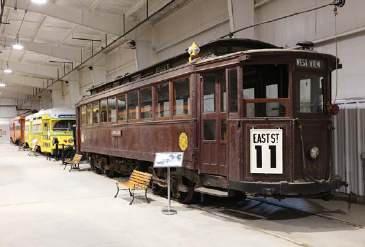
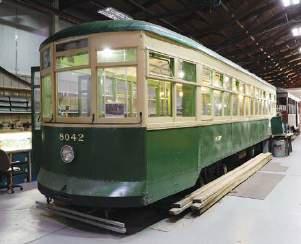
found throughout the Pittsburgh system and were popular both with management and passengers; the lower steps speeded boarding and alighting, and allowed faster schedules.
At the instigation of PRC’s General Manager, Westinghouse Electric developed smaller motors to fit under cars of this design. Literally tens of thousands of low-floor cars were subsequently built for tramways throughout North America. Car 4398 is double-ended, one of the last such that remained in revenue service until 1952. It was then placed in an emergency reserve until purchase by the Pittsburgh Electric Railway Club in 1956. More recently it has been completely rebuilt in the PTM workshop to render it fit for many years of further service at the museum.
Low-floor bogie car 3756 was one of 20 such vehicles built in 1925 by Osgood Bradley to replace the heavy wooden-bodied interurban cars used on the Washington and Charleroi interurban lines. They were effectively single-ended cars with back-up controllers and fitted with couplers and multiple-unit controls for operation in two-car trains, but were unpopular with staff and passengers and cascaded to other lines as early as 1928.
During World War Two, nine of the class were transferred to serve shipyards on Neville Island and fitted with an offside front door, to prevent alighting passengers from stepping into a busy highway.
Selected for preservation from over 200 candidates in 1954, 3756 has since led a charmed existence. It was overhauled and returned to Pittsburgh’s streets for the bicentennial celebrations of 1976, and in May 1987 returned for the grand inauguration of the South Hills Light Rail line. For this it was fitted with a pantograph, enabling it to operate over the entire LRT system.
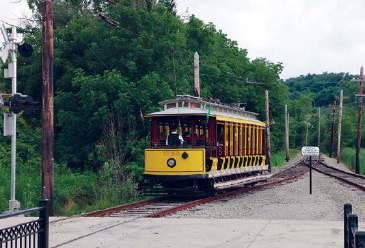
3
2. Looking care-worn after a long life of 120 years is Pittsburgh Railways bogie car 3487, the oldest complete bogie car in the collection, from 1905. It is a product of the St Louis Car Company and is depicted on display in the Trolley Display Building on 4 July 2023.
3. A look along the private right-of-way from Fairgrounds loop with the much-loved Rio de Janeiro cross-bench car 1758 en route to Arden loop terminus. 4 July 2023.
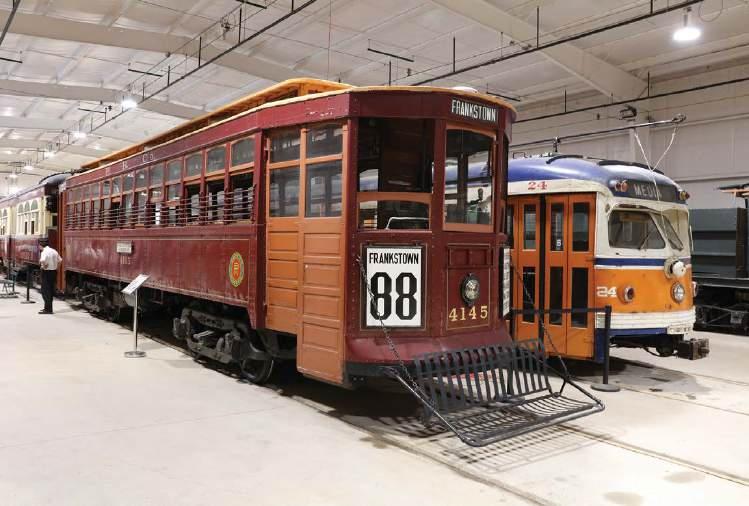
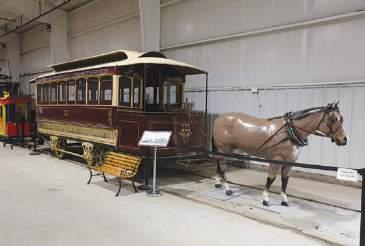
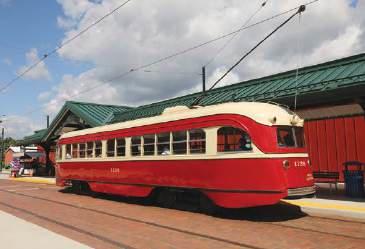
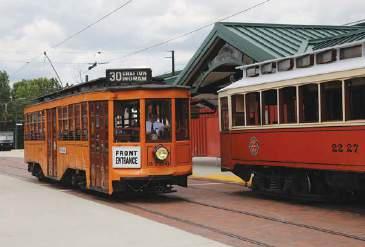
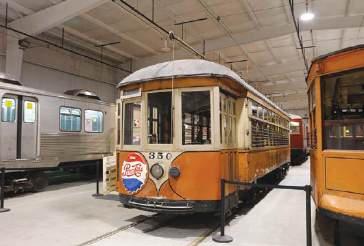
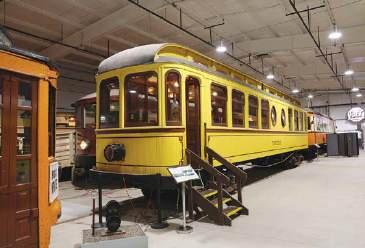
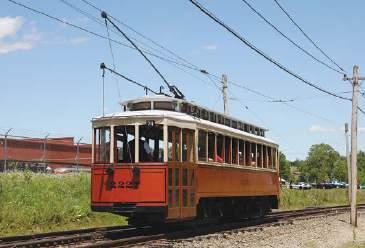
1. Restoration work on Philadelphia Rapid Transit car 8042 is proceeding well, as illustrated by this workshop view on 7 June 2024. Built by Brill in 1923, it received a substantial mid-life upgrade in 1940. It was retired from Philadelphia service at the end of 1957.
4. Pittsburgh Railways Company car 4145 was one of 130 high-floor cars built in 1911 by the Pressed Steel Car Company of McKees Rocks. It enjoyed a long after-life in the PRC works fleet, and is now a member of the PTM operational fleet. It is seen here in the Trolley Display Building on 4 July 2023.
5. Horse-drawn car 101 dates from the mid-1870s and was built by the John Stephenson Company of New York. It has been restored to represent the former Federal Street and Pleasant Valley line. 4 July 2023.
6. Not currently in operation is this representative of one of North America’s favourite tramway towns, Johnstown, Philadelphia. This continued running trams such as this bogie car built by St Louis Car Company in 1926 long after most others had long since given up. 4 July 2023.
7. Representing Pittsburgh Railways’ first delivery of PCC cars from the St Louis Car Company in 1937 is 1138, seen in this offside rear view outside the main exhibition hall. 7 June 2024.
8. This un-numbered premium bogie car named ‘Toledo’ was acquired by the museum in 2009; it is one of several cars built for conveying special parties. It is thought to have originated in the Lake Shore Electric Railway area on the line connecting Cleveland and Toledo. 4 July 2023.
9. Drop-centre bogie car 3756 of the Pittsburgh Railways fleet exemplifies the fleet of Osgood Bradley cars dating from the mid-1920s, but since arriving at PTM has become one of its most regular performers. 7 June 2024.
10. Cincinnati was one of only three North American tramways required to operate using the double trolley system. This car dates from 1919 and was in Cincinnati city service until the end of streetcar operations there in 1951. 8 June 2024.
All photography by Mike Russell on dates stated.
The remaining cars from the Pittsburgh fleet are all PCCs, ranging from a pre-World War Two example (1138) to one of those substantially rebuilt by Port Authority Transit (PAT) in South Hills shops in 1988. Car 1138 entered service in November 1937 and worked through to early 1960, when it was withdrawn as a result of the abandonment of the West End lines. Its maintenance history and sound structural condition rendered it a prime candidate for selection amongst some 200 early PCC cars. When first restored in the later 1960s, it was returned to 1937 appearance. It suffered from weather damage and in 2000-01 was taken to the Adtranz (now Bombardier Transportation) facility in Elmira, New York, where it was restored to a mid-1950s look.
Car 1467 comes from PRC’s fourth order for PCC cars. Delivered in March 1942 it embodies the first design modifications to the standard PCC streetcar. Structurally and mechanically it is very similar to 1138, improved lighting and ventilation and an anti-glare slightly raked front windscreen being the only significant modifications. In 1963 the car was purchased from PRC by the Union Switch and Signal Division of the
Westinghouse Air Brake Company for tests of automatic control equipment for rapid transit operations on a long stretch of the Library line. On conclusion of the testing in 1968, Westinghouse donated the car to the PTM after removal of its sophisticated equipment. Car 1799 was delivered as 1613; the 1600 series included the last 99 cars of the pre-war design built by the St Louis Car Company. In January 1946, 1613 became a prototype for the adaptation of PCC cars for interurban service. It had specially designed trucks, a two-way ‘trolleyphone’ and, subsequently, a roof-mounted headlamp. Car 1613 survived in this form until 1979 when it was overhauled and reconfigured, the last to be dealt with in a programme that started in 1973. As a result it was renumbered 1799 and repainted into a variation of its original colour scheme. It was acquired by the museum in 1990.
Pittsburgh’s newest PCC cars, 100 units delivered in 1948-49, were undoubtedly the most distinctive and featured several differences from their predecessors: sealed windows with small standee windows above, roof cowling housing ventilation facilities, and a new interior layout allowing all seated
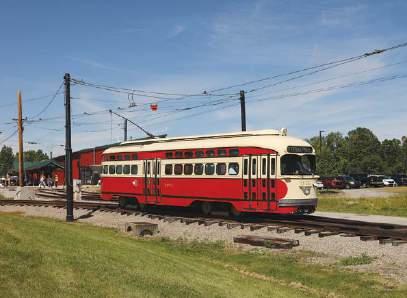
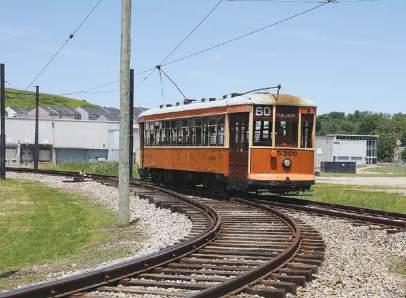
passengers to face forward. Of these, 25 cars (1700-1724) were equipped with special running gear, a package shelf, ticket printer, emergency tool kit, spare trolley pole and a roof-mounted headlamp for service on PRC’s interurban lines to Charleroi and Washington. Car 1711 was selected for preservation because it operated on the line that became the PTM’s home, and was the last car to carry passengers from Washington to Pittsburgh early on 30 August 1953. It was retired from service in August 1988 and acquired from PAT in April 1990. It has twice been restored, most recently by Adtranz in 2001 when it was returned to the ‘factory fresh’ condition in which it operates today.
PCC 4004 was restored by PAT following rebuilding as part of the LRT project, for which it is now fitted with a pantograph. This was the last car to carry passengers on the final day of PCC operation in Pittsburgh in September 1999, ending 63 years of PCC car operation. The car was then donated to the museum.
The latest addition to the collection of PCC cars is 1713, branded as ‘The Terrible Trolley’ at the suggestion of young museum volunteers, who recall its former appearance
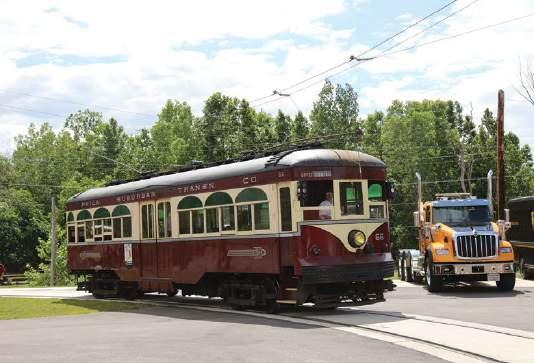
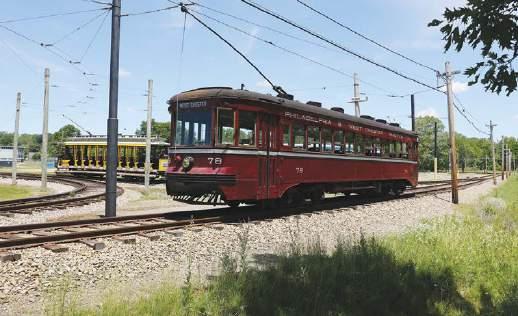
in recognition of local football club ‘The Steelers’ during the last years of PAT PCC operation. Restoration has been carried out by young volunteers in an initiative to engage their active participation in the museum’s work, with the laudable aim of providing future workforce continuity.
Philadelphia legacy
Aside from its impressive Pittsburgh collection, the PTM also conserves 11 cars from the Philadelphia system, which is still partly in operation today. Several are from the interurban fleet once belonging to the Philadelphia Suburban Traction company (PS), latterly part of SEPTA’s Red Arrow Division. Cars 14 and 24 are from a batch of St Louis-built bogie vehicles delivered in 1949, commonly considered to be the last interurban cars built in the USA. While 14 has been restored to Philadelphia Suburban livery, 24 represents the class as operated in the SEPTA era. The pair were chosen to enable the museum to demonstrate multiple-unit operation as undertaken until the late 1930s. They were retired from Red Arrow service in September 1982.
A pair of centre-entrance bogie cars (66 and 73) represent an earlier period on the Red Arrow Division, with 73 repainted in its original Philadelphia and West Chester Traction Company (PWC) livery (prior to that organisation’s 1936 renaming as PS). These were Brill products, and although latterly reduced to special duties were both still on SEPTA’s roster in 1970.
Car 66 is to be restored to make a matching twin-set with 73. A later, lighter-weight car is 78, one of ten ordered from Brill in 1931-32 to revive the fortunes of the PWC during tough economic times. These were so reliable and successful in reducing operating costs that some were still in service into the 1980s, latterly mainly in peak periods. A later delivery of ten lightweight cars was made by Brill in 1941 – these being christened ‘Brilliners’ – the company’s response to the successful PCC cars built by the St Louis Car Company. Car 5 has the distinction of being one of the batch that turned out to be the last streetcars manufactured by Brill, which had once been the world’s most prolific streetcar builder.
Later generation cars from Philadelphia are PCCs 2711 and 2723, St Louis Car Company products of 1947, now painted in different liveries to represent early and later stages in their career; they survived in traffic until the early 1990s. Through the generosity of Adtranz, 2711 was adapted to enable the carriage of wheelchairs.
The final representatives of Philadelphia passenger stock are cars 5326 and 8042. The first was a double-ended car built by Brill in 1923 for the Philadelphia Rapid Transit Company; it was mounted on maximumtraction bogies, two motors being deemed adequate for operation in the city with its absence of steep hills. The car was part of a major modernisation and upgrading of stock in 1941, changes which were reversed after the vehicle joined the PTM in 1957, and was restored with official grants for the
1976 bicentennial celebration. Car 8042, however, is a single-ended version, one of 385 ordered in 1923. It was later to be one of 86 such cars modified for one-manoperation and last operated in December 1957. After a peripatetic existence it ended up at Scranton under the stewardship of the Electric City Trolley Museum Association, from which the PTM acquired it in 2005, whilst acknowledging ECTMA’s sponsorship of the car.
The collection includes two members of the former West Pennsylvania Railways fleet. Car 739 is a massive drop-centre equal-wheel bogie vehicle dating from 1925, built in the company’s own workshops at Connellsville,
“Museums of this status are the products of thousands of hours of voluntary work by devotees.”
that remained in service until the end of West Penn’s rail operations in 1952. The body was subsequently sold for private use and 739 became a family residence. Originally sister car 722 was to be preserved, but its condition was seriously deteriorated. When 739 was offered to the PTM in 1988 it was acquired, permitting 722 to be used as a donor car.
Car 832, however, was a conventionallydesigned bogie car with end entrances and, built by the Cincinnati Car Company, featured that builder’s distinctive curved side design. Entering service in 1930 and surviving until 1952, this is now the only surviving complete and operational car of this design preserved in a museum.
Strangely, the PTM possesses a second car numbered 832. This came from the New Orleans operation (NOPSI) and is one of the famous Perley Thomas bogie cars of 1923, many of which still serve the city’s historic St Charles line.
There are several cars awaiting restoration that originated with minor operations in the Pennsylvania area and surroundings – too many to detail here – but a final rolling stock review should identify three more highlights. A special case is Cincinnati 2227, one of 105 bogie cars ordered by the Cincinnati Traction Company in 1919; like all other trams operated in this city it was equipped with double trolley poles for current collection on the twin overhead installed to protect against fears of corrosion to underground conduits and water pipes. After a nomadic life following withdrawal in 1951 it eventually acquired refugee status at the museum. Among the first jobs was restoring its broad-gauge trucks, enabling the car from May 2013 to operate with much of its original running gear.
Johnstown 350 is a treasured specimen. This classic St Louis-built bogie car of 1926
survived in the fleet well after it was truly required to provide service, for Johnstown was the last of the typical small-town tramway operators in the USA. Although its fleet of 20 PCC cars was adequate to provide scheduled public services for its last years, the older bogie cars were so popular for fan trips that the company kept several for this purpose. Closure of the Johnstown tramways in June 1960 brought the era of the classic American streetcar to an end.
Car 1758, mentioned last issue, is a particular favourite with visitors, being a representative of the so-called Breezers (open-sided cross-bench cars) that were popular with many operators in the early years of electric traction. This vehicle was one of several 13-bench cars built under licence from Brill in the workshops of the Rio de Janeiro tramways in 1911; many remained in service until 1963. Of those, 12 were bought as a bulk purchase by a consortium of American museums. Although the PTM was not one of the original contributors, this car came to the museum in 2006 after a varied career in heritage service elsewhere. The car features the Narragansett nearside two-step arrangement patented by Brill for ease of boarding and alighting.
The museum contains an array of structures (such as wayside shelters) and artefacts to complement the rolling stock, whilst the Visitor Centre is a spacious pavilion with a well-designed layout displaying a variety of paraphernalia, together with archive material.
Particular reference should be made to the museum’s official guidebook, from which much rolling stock information has come for this feature. This 96-page tome is a model of its kind and an invaluable guide for any serious-minded visitor to the museum.
Museums of this status are the products of thousands of hours of voluntary work by devotees, but also require a visionary leader who can project the museum’s ethos, aims and aspirations to ensure relentless focus on the concept as well as projection of the museum’s work to the public. In the case of the PTM this role has been admirably filled over a period of 32 years by Scott Becker, who will retire from his post as Executive Director and CEO on 31 May.
Without in any way detracting from the voluntary work of all who contribute to the museum, it must be acknowledged that the PTM’s growth and success has been successfully spearheaded by Mr Becker, and that his personal contribution has been invaluable. He will be succeeded by his deputy, Jeanine LeBor, ensuring vital continuity.
Fortunately, Scott Becker’s enthusiasm and experience will not be lost to the museum as he intends to continue his voluntary involvement into retirement. His is certainly a legacy of which to be extremely proud.
The PTM is located at 1 Electric Way, Washington, Pennsylvania 15301. Opening hours are Thursday to Sunday throughout the year, 10.00-16.00, with extended hours in summer. For full details, see: www.pa-trolley.org


By Paul Rowen
Fifteen LRTA members recently visited the expanding light rail system in the UK’s West Midlands. Organised by LRTA Council Member Dr. David Walmsley, the visit started with a look at battery operation on the trams in Birmingham Centre, followed by a visit to the depot at Wednesbury.
The group had an opportunity to try the simulator used to train drivers, including several of the new routes.
Following this, the members toured the depot and learned about its current expansion plans.
After a tour of the workshop, the group was given a presentation on battery operation
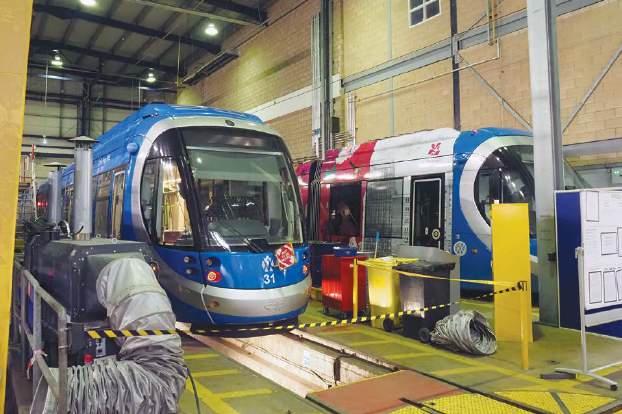
MAY
Thursday 1. Brentford 14.30. Eddie Dawes: London trams crossing railways. London Museum of Water and Steam, TW8 0EN. Contact: thamesvalley@tlrs.info GBP5 inc. refreshments. (TLRS) Tuesday 6. Southampton 19.30. Roger Manley shares some of his recently digitised ciné films, including material on urban and Vicinal trams in Brussels. Junction Church (Former Railway Institute) Eastleigh, GBP3. (LRTA/SEG)
Monday 12. Leeds 19.30. John Holmes: European travels. Engine House, Middleton Railway, LS10 2JG £1 (includes light refreshments). Contact: enquiries@lths.co.uk. (LRTA/LTHS) Wednesday 14. Sussex 19.40. Keith Goodsell: Swiss Railway Wonderland. Southwick Community Centre, BN42 4TE. Contact: sussex@ tlrs.info. GBP2 visitors. (SEG) Saturday 17. Coatbridge 13.00. Scottish trams show and tell & talk TBC. Contact: scotland@tlrs.info. (TLRS)
and the steps the Combined Authority had to go through to obtain regulatory approval. At this stage the group were joined by David Keay, the ‘independent competent person’ who had advised the authority.
Afterwards, several members adjourned for liquid refreshments at the Great Western in Wolverhampton.

The Association is pleased to announce that its new shop is now operational. The shop is designed to present the books in a more visual manner, by geographic area rather than publisher.
Currently we have a limited range of books in stock, however, within a short time we expect to have the full range available.
Members who wish to have their 10% discount will need to register using the e-mail held by the Association. You will then be asked to reset your password.
Compiled by the LRTA. For a full list of the year’s events and meeting places, including online meetings, visit www.lrta.org
Monday 19. Solent 19.30. TLRS Zoom call replays. St. Nicholas’s Church Hall, PO17 6HP. Contact: solent@tlrs.info GBP2. (TLRS) Monday 19. Merseyside 19.30 for 19.45. Annual General Meeting and models evening. Sefton Park Community Association, L17 3AG. Contact: merseyside@tlrs.info. Saturday 24. Taunton 14.00. Brian Boddy: Bitten by the transport bug. West Monkton Village Hall, TA2 8NE. Contact: westofengland@tlrs. info. GBP2 inc. light refreshments. (TLRS)
Saturday 31. Nottingham 14.00. John Crofts, Nottingham tramways. Beeston Scout Hut, NG9 1GA. Contact: chairman@tlrs.info. (TLRS) Saturday 31 . Visit to Blackpool model show. 1PA. Contact: archivist@tlrs.info. (TLRS)
JUNE
Tuesday 3. Southampton 19.30. Members’ digital images. Junction Church (Former Railway Institute) Eastleigh, GBP3. (LRTA/SEG)

Order online from www.lrta.info/shop – or by post from:
LRTA Publications, 38 Wolseley Road, SALE, M33 7AU
(Please provide telephone contact details and quote LRTA membership number if applicable)
Outside UK = Airmail to Europe (includes all of Russia) / Surface mail to rest of world; Airmail Zone 1 = outside Europe excluding Australia, New Zealand & USA; Airmail Zones 2/3 = Australia, New Zealand & USA
The first in a series of three books covering many of the tramways and electric light railways still operational in Spain in the mid-1950s. Barcelona was an absolute must for anyone interested in electric traction, with two track gauges, city and interurban operation, and a wealth of car types including double-deckers and PCCs acquired second-hand from the USA. To complement these were the delightful Tibidabo tram.
Valencia, too, had much to offer with a complex city system and some long interurban lines, most of which are still operating.
The island of Mallorca had many gems, some of which still run today – but sadly the charming city trams in Palma have now all gone.
One man provided the inspiration for this series – Ray DeGroote from Chicago, who embarked on a series of world travels during the mid-1950s, during which he visited and photographed many now long-abandoned tramways.
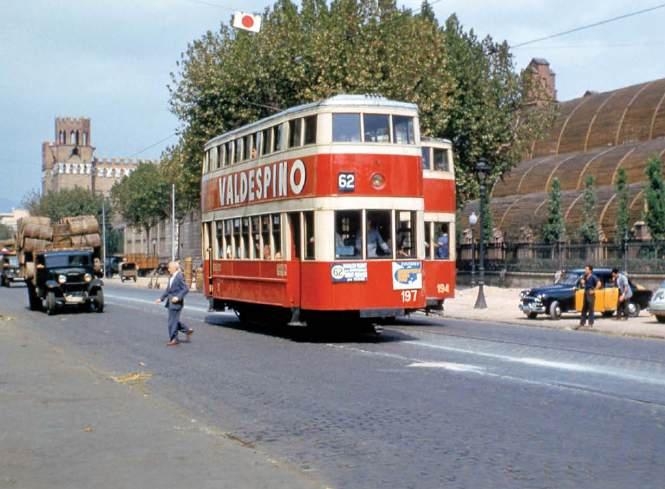
Martin Jenkins and Charles Roberts
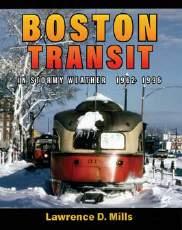

> A4 hardback, landscape format; 144 pages, fully illustrated in colour throughout.
£42.50 (UK addresses); £54.00 (outside UK);
£66.00 (Airmail Zone 1); £67.50 (Airmail Zone 2/3); LRTA Members: £3.90 discount
A must for fans of PCC cars, this colourful volume illustrates the often-snowy conditions encountered by streetcars on the Green Line network in Boston, USA. The author grew up in the city and took all the atmospheric pictures shown in the book. There are chapters on the various sections of the light rail lines, plus a look at the Blue Line heavy metro as well as the severe flooding experienced in 1962 and 1968. In addition, the transition from PCCs to the disastrous Boeing-Vertol LRVs is covered.
> Softback, 280x215mm, 74 pages, 171 colour and 19 black & white pictures. £42.50 (UK addresses); £48.50 (outside UK); £51.00 (Airmail Zone 1); £53.50 (Airmail Zones 2/3); LRTA Members: £4.00 discount
For further details of all these books go to our website.
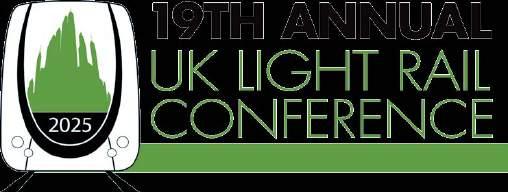
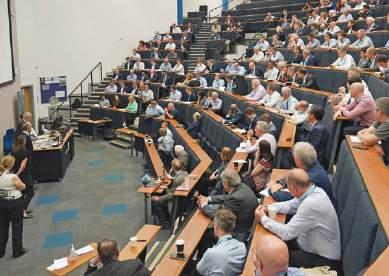


Discover all the speaking, sponsorship and exhibiting options available to you at the 2025 UK Light Rail Conference –e-mail: conferences@mainspring.co.uk

Now in its 19th year, the UK’s ONLY dedicated light and urban rail conference, exhibition and networking event is renowned as being THE place to create long-lasting relationships within LRT. Contact us:



